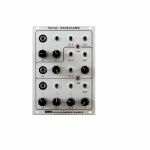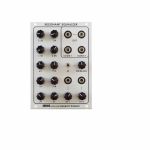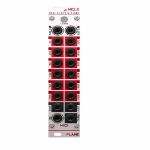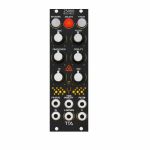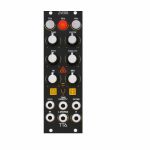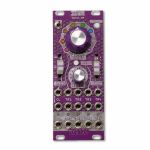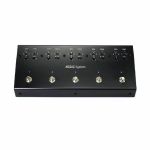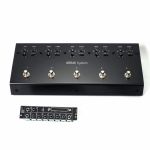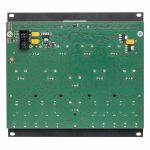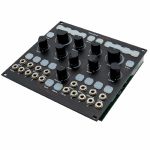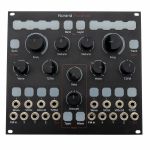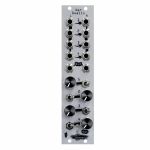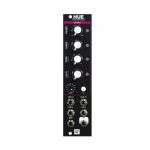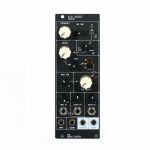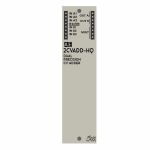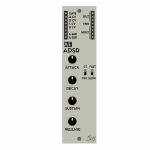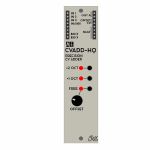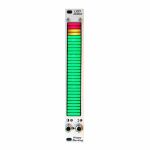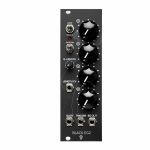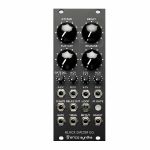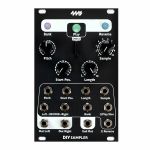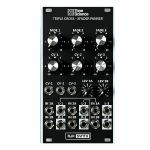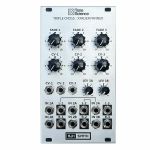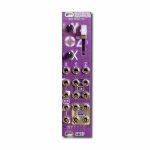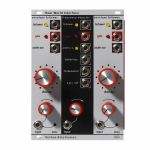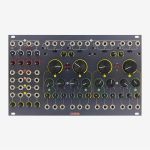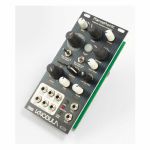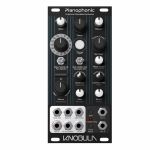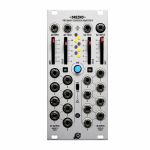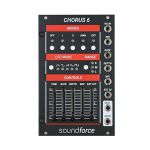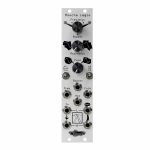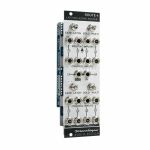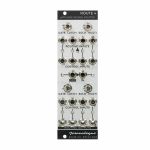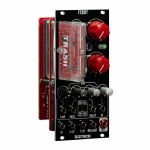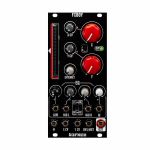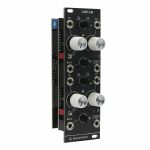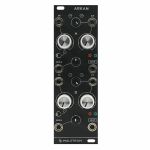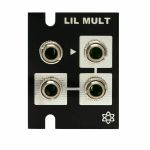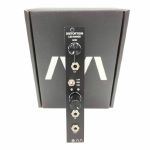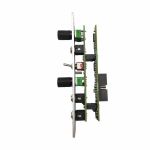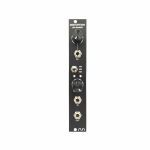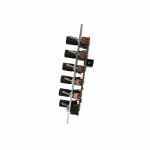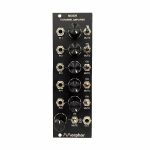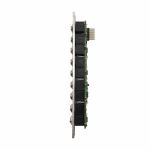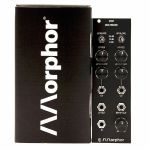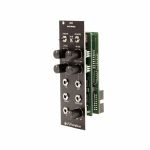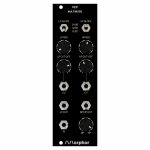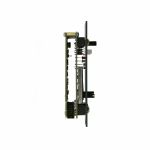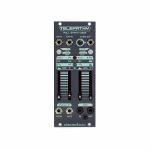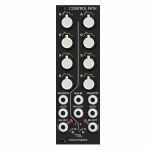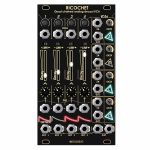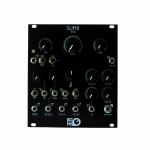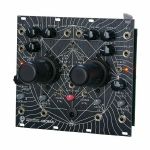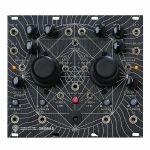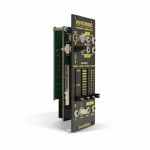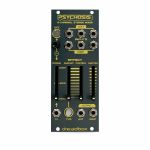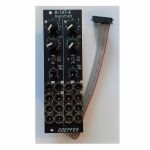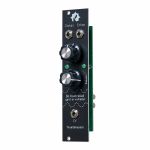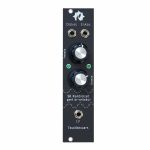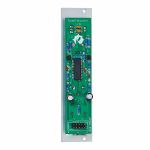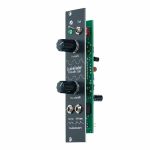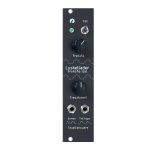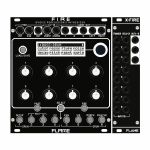100% Secure Shopping
Studio equipment
Our full range of studio equipment from all the leading equipment and software brands. Guaranteed fast delivery and low prices.
100% Secure Shopping
DJ equipment
Our full range of DJ equipment from all the leading equipment and software brands. Guaranteed fast delivery and low prices. Visit Juno DJ
Filter
Coming Soon
Equipment
Format
Release Date
900
Not Forthcoming
81
Forthcoming
4
Last Week
7
Last 2 Weeks
18
Last Month
49
Last 2 Months
169
Last 6 Months
256
Last Year
Brand
Featured
Price
Tags
Serge Triple+ Waveshaper Module (effect/waveshaper module)
Cat: 757127 Rel: 15 Oct 20
Triple waveshaper module - 18HP
Notes: The Triple Waveshaper (TWS) is a non-linear modifier which can transform a sawtooth wave into a sine wave. This classic module incorporates three independent waveshapers for modifying synthesizer waveforms or for processing signals from preamplified instruments. Although originally designed as a waveshaper for early Serge oscillators, this module has been found to be a excellent modifier of electronic and acoustic sounds, and is highly recommended for subtle timbral modifications beyond the range of simple oscillator/filter patches.
The R*S version extends the classic TWS concept:
+1: An additional (4th) waveshaper has been added (right after the first / bottom waveshaper) that can be dialed in smoothly using the +1 knob. Turned down (CCW) the bottom section acts as in the original (as if that additional waveshaper would not exist). Turned up (CW) the bottom section is actually 2 waveshapers in series.
Switches to link the 3 sections - bottom to top. Using these switches all sections can be set to act in series, starting at the bottom and ending at the top, providing the combined effect of 3 to 4 waveshapers (or anything in between) using the +1 knob.
Linking only the middle and top section and turning the +1 knob up (to have 2 sections in the bottom) allows you to use the module for isntance as two independent 2-stage waveshapers (using bottom in and out for one and middle in and top out for the other) - e.g. for stereo processing.
… Read moreThe R*S version extends the classic TWS concept:
+1: An additional (4th) waveshaper has been added (right after the first / bottom waveshaper) that can be dialed in smoothly using the +1 knob. Turned down (CCW) the bottom section acts as in the original (as if that additional waveshaper would not exist). Turned up (CW) the bottom section is actually 2 waveshapers in series.
Switches to link the 3 sections - bottom to top. Using these switches all sections can be set to act in series, starting at the bottom and ending at the top, providing the combined effect of 3 to 4 waveshapers (or anything in between) using the +1 knob.
Linking only the middle and top section and turning the +1 knob up (to have 2 sections in the bottom) allows you to use the module for isntance as two independent 2-stage waveshapers (using bottom in and out for one and middle in and top out for the other) - e.g. for stereo processing.
1 in stock $279.96
Click for better price!
or call +44 20 7424 1960
quote 757127
quote 757127
Serge Resonant Equalizer 10-Band Filter Module (equalizer/filter module)
Cat: 757149 Rel: 15 Oct 20
10-band filter module - 18HP
Notes: The RESONANT EQUALIZER (EQ) is a unique ten-band filter designed specifically for electronic sound synthesis and processing. Except for the top and bottom frequency bands, the bands are spaced at an interval of a major seventh. The Resonant Equalizer is designed to produce formant peaks and valleys similar to those in acoustic insstruments.
There are three equalized outputs: the two COMB outputs provide the sums of the two alternate filter bands, while the two top outputs are the (identical) mix of all filter bands. Please note that there is no sharp separation between the bands, moving any frequency knob will have an influence on both COMB outputs. This equalizer is special in that the bands can be set to be resonant: when the knobs are in the middle position, the response at the main EQ Output is flat. When the knobs are positioned between the 9 and 3 o'clock position, up to 12 db of boost or cut is set at the band. If the knob is set beyond the 3 o'clock position, the band will become resonant, simulating the natural resonance of acoustic instrument formant structures. Below the 9 o'clock position, increased band rejection is achieved.
The Random*Source version of the filter is a licensed and authorized adaption of the legendary Serge equalizer for Eurorack. It adds an input mixer with 2 inputs that can be built/used to attenuate or amplify/distort the input signal(s) before they are sent into the EQ and a Feedback section (knob and phase switch) which allows to feed back the output signal or the inverted output signal (depending on the Phase switch). Adding inverted feedback leads to phase cancellation effects - unlike the "normal" feedback, level decreases and the signal thins out.
… Read moreThere are three equalized outputs: the two COMB outputs provide the sums of the two alternate filter bands, while the two top outputs are the (identical) mix of all filter bands. Please note that there is no sharp separation between the bands, moving any frequency knob will have an influence on both COMB outputs. This equalizer is special in that the bands can be set to be resonant: when the knobs are in the middle position, the response at the main EQ Output is flat. When the knobs are positioned between the 9 and 3 o'clock position, up to 12 db of boost or cut is set at the band. If the knob is set beyond the 3 o'clock position, the band will become resonant, simulating the natural resonance of acoustic instrument formant structures. Below the 9 o'clock position, increased band rejection is achieved.
The Random*Source version of the filter is a licensed and authorized adaption of the legendary Serge equalizer for Eurorack. It adds an input mixer with 2 inputs that can be built/used to attenuate or amplify/distort the input signal(s) before they are sent into the EQ and a Feedback section (knob and phase switch) which allows to feed back the output signal or the inverted output signal (depending on the Phase switch). Adding inverted feedback leads to phase cancellation effects - unlike the "normal" feedback, level decreases and the signal thins out.
1 in stock $391.94
Click for better price!
or call +44 20 7424 1960
quote 757149
quote 757149
Flame uMCLK MIDI Clock Divider Module (clock modulator/MIDI module)
Cat: 757290 Rel: 26 Feb 20
MIDI clock divider module - 5HP
Notes: The "uMCLK Divider" module can either work as a MIDI clock divider or as an analog clock divider. The divider outputs are assigned differently in both operating modes.
After receiving a MIDI start command, the module works as a MIDI clock divider. There are fixed dividers on 11 outputs. Via the divider output KEYS, triggers can be triggered and mixed via MIDI notes. The keyboard zone extends over three octaves. With the help of the LEARN key, the receive MIDI channel and the lowest note of this 3-octave range can be defined.
When stopped (i.e. after receiving a MIDI stop command or after switching on), the module works as an analog clock divider and divides the analog clock present at the CLOCK input. The 12 analog divider outputs can be reprogrammed via SYSEX. Ready-made SYSEX files are already available (e.g. for even / odd dividers, Fibonacci series, offbeats, etc.). The RESET input resets the analog counters or serves to deactivate the analog divider.
Connections:
- Ribbon cable adapter for Doepfer bus +/-12Volt
- Inputs: 2x Clock/Gate,Reset (0/+5..10V), 1/8th inch mono jacks
- 1x MIDI (TRS-B standard) 1/8th inch stereo jack Outputs: 1x MIDI (TRS-B standard) 1/8th inch stereo jack
- 14x Clock/Gate Divider, 1/8th inch mono jacks
Control elements:
- 1 push button with LED (LEARN key) 16 LED's
- Current consumption: max. +70..80mA / - 0 mA
- Size: Euro rack format 3U / 6HP 30x128,5x40 mm
Dimensions
5 HP
40 mm deep
Current Draw
80 mA +12V
… Read moreAfter receiving a MIDI start command, the module works as a MIDI clock divider. There are fixed dividers on 11 outputs. Via the divider output KEYS, triggers can be triggered and mixed via MIDI notes. The keyboard zone extends over three octaves. With the help of the LEARN key, the receive MIDI channel and the lowest note of this 3-octave range can be defined.
When stopped (i.e. after receiving a MIDI stop command or after switching on), the module works as an analog clock divider and divides the analog clock present at the CLOCK input. The 12 analog divider outputs can be reprogrammed via SYSEX. Ready-made SYSEX files are already available (e.g. for even / odd dividers, Fibonacci series, offbeats, etc.). The RESET input resets the analog counters or serves to deactivate the analog divider.
Connections:
- Ribbon cable adapter for Doepfer bus +/-12Volt
- Inputs: 2x Clock/Gate,Reset (0/+5..10V), 1/8th inch mono jacks
- 1x MIDI (TRS-B standard) 1/8th inch stereo jack Outputs: 1x MIDI (TRS-B standard) 1/8th inch stereo jack
- 14x Clock/Gate Divider, 1/8th inch mono jacks
Control elements:
- 1 push button with LED (LEARN key) 16 LED's
- Current consumption: max. +70..80mA / - 0 mA
- Size: Euro rack format 3U / 6HP 30x128,5x40 mm
Dimensions
5 HP
40 mm deep
Current Draw
80 mA +12V
1 in stock $180.41
Click for better price!
or call +44 20 7424 1960
quote 757290
quote 757290
TipTop Audio Z5000 Multi-Effect Module (black) (digital/effect synth module)
Cat: 757470 Rel: 20 Apr 20
Powerful DSP effects module - 8HP
Notes: Updated version of a truly pioneering Eurorack module that introduced DSP effects to the format. Still sounds great, still versatile, still excellent value.
Supplier's notes:
Back in 2008, the original Z5000 was not only the world's first Eurorack DSP effects module but also the first Tiptop Audio module released. It brought voltage controlled digital effects to Eurorack for the first time and the Z5000 was eventually replaced by the Z-DSP open source platform. Now, years later with over a decade of experience developing audio effects for Eurorack signals we are introducing a totally new version of the Z5000: a compact stereo 8HP multi effect with voltage controlled parameters, VC analogue clock generator driving the DSP chip and 24 of our creme de la creme reverbs, delays, modulation, harmonization and pitch modulated effects. A number of programs in the Z5000 combine more than one effect, in series or parallel, that represent studio techniques from the early days till modern times often leaning toward the more experimental side.
… Read moreSupplier's notes:
Back in 2008, the original Z5000 was not only the world's first Eurorack DSP effects module but also the first Tiptop Audio module released. It brought voltage controlled digital effects to Eurorack for the first time and the Z5000 was eventually replaced by the Z-DSP open source platform. Now, years later with over a decade of experience developing audio effects for Eurorack signals we are introducing a totally new version of the Z5000: a compact stereo 8HP multi effect with voltage controlled parameters, VC analogue clock generator driving the DSP chip and 24 of our creme de la creme reverbs, delays, modulation, harmonization and pitch modulated effects. A number of programs in the Z5000 combine more than one effect, in series or parallel, that represent studio techniques from the early days till modern times often leaning toward the more experimental side.
1 in stock $205.30
Click for better price!
or call +44 20 7424 1960
quote 757470
quote 757470
Tiptop Audio ZVERB Reverb Effects Module (black) (digital/effect/reverb synth module)
Cat: 757471 Rel: 16 Dec 19
Reverb effects module in 8HP.
Notes: ZVERB is a collection of all new reverb algorithms developed by Tiptop ranging from typical reverbs to more complex effects that combine delay and pitch shifting with reverb. The effects are grouped by decades based on either the era an algorithm was introduced or the time when the effect was most popular. This variety of reverbs covers small to epic size spaces with the addition of shimmering, feedback tunnelled pitch shifting, tape delay drivers, gated reverbs and a lot more. Analog clocking of the DSP chip and CV over the parameters enables even more experimentation. This is a collection inspired by the best from the past right at your fingertips.
… Read more 1 in stock $205.30
Click for better price!
or call +44 20 7424 1960
quote 757471
quote 757471
Mystic Circuits IDUM Gate Processing Effect Module (clock modulator/effect/frequency divider/looper/quad/random module)
Cat: 875962 Rel: 12 Jul 22
Gate processing effect module - 10HP
Notes: Instant IDM! An unusual genre-specific module from Mystic Circuits, automatically generating complex trigger sequences. Create loops or apply real-time effects to a trigger or gate input.
Supplier's Notes:
IDUM is a gate processing effect that turns its input effortlessly into IDM. Making complex electronic music with the modular usually requires meticulous sequencing done in advance or a large ecosystem of modules. Unfortunately, the level of expertise needed to accomplish this is not accessible to the average modular user. IDUM aims to make this process easier and put Intelligent Dance Music, also known as IDM, into the hands of people with average intelligence. IDUM does not require much knowledge to get immediate and compelling results; but with some extra familiarity, this module can enable innovative music making techniques. Instead of generating musical patterns on its own, IDUM acts like an effects processor for the sequences that run through it. For example, a filter or a delay allows the user to alter their sound by twisting the knobs or modulating the parameters. Similarly, IDUM manipulates the actual gates and sequences of connected modules, but with a level of playability normally inaccessible to a sequencer. IDUM can vary carefully crafted sequences or turn your music into an onslaught of controlled chaos. Its open source code and hardware based on the beginner friendly Arduino Nano Every encourage users to tweak their modules to taste or to add new features all while ensuring future improvements as IDUM makes its way into the wild.
IDUM has eight effect modes:
HOLD - Alter the length of incoming triggers.
BURST - Generates a ratcheting effect with timing determined by the clock.
MULTIPLY/DIVIDE - Generates a ratcheting effect with timing determined by incoming triggers.
BALL - Generates a bouncing ball effect.
ROTATE - scrambles the connections of inputs and outputs.
DELAY - postpones incoming gates by a dynamic amount of time based on incoming triggers.
BREAK - preset rhythms that turn incoming triggers into breakbeats.
SKIP - manipulates the clock output to multiply the clock speed or skip forward multiple steps.
In addition to these modes, IDUM features an eight step looper that loops incoming gates as well as any effects that were active on those steps.
To control when IDUM's effects are active, the CHANCE slider sets the likelihood that on a given step an effect will activate and the LENGTH slider sets how many steps the effect will last for. The PARAM knob controls a parameter unique to each effect while the MODE knob selects the mode. All of these controls as well as the LOOP status have their own CV modulation inputs.
Unique to IDUM is its ability to manipulate external sequencers using the clock output. This includes functions like: pausing the clock when an effect is active for dynamic clock division, skipping forwards or multiplying the speed of the clock in SKIP mode, and looping a sub-section of sequencer steps in the looper. To keep everything tamed while manipulating the clock, the CYCLE switch will send out bursts of clocks to catch your sequencer up with its original sequencer position after an effect has completed. Keep in mind that not all sequencers like to be clocked fast enough to work with these features, so for best results pair your IDUM with a TREE/ LEAVES combo from Mystic Circuits.
IDUM might be the stupidest way to make IDM and Mystic Circuits are proud of that. Whether you want to add complexity to your dance floor bangers or make the most obtuse and unlistenable music imaginable, IDUM is here to help. See just how dumb your music can get with the Mystic Circuits IDUM.
… Read moreSupplier's Notes:
IDUM is a gate processing effect that turns its input effortlessly into IDM. Making complex electronic music with the modular usually requires meticulous sequencing done in advance or a large ecosystem of modules. Unfortunately, the level of expertise needed to accomplish this is not accessible to the average modular user. IDUM aims to make this process easier and put Intelligent Dance Music, also known as IDM, into the hands of people with average intelligence. IDUM does not require much knowledge to get immediate and compelling results; but with some extra familiarity, this module can enable innovative music making techniques. Instead of generating musical patterns on its own, IDUM acts like an effects processor for the sequences that run through it. For example, a filter or a delay allows the user to alter their sound by twisting the knobs or modulating the parameters. Similarly, IDUM manipulates the actual gates and sequences of connected modules, but with a level of playability normally inaccessible to a sequencer. IDUM can vary carefully crafted sequences or turn your music into an onslaught of controlled chaos. Its open source code and hardware based on the beginner friendly Arduino Nano Every encourage users to tweak their modules to taste or to add new features all while ensuring future improvements as IDUM makes its way into the wild.
IDUM has eight effect modes:
HOLD - Alter the length of incoming triggers.
BURST - Generates a ratcheting effect with timing determined by the clock.
MULTIPLY/DIVIDE - Generates a ratcheting effect with timing determined by incoming triggers.
BALL - Generates a bouncing ball effect.
ROTATE - scrambles the connections of inputs and outputs.
DELAY - postpones incoming gates by a dynamic amount of time based on incoming triggers.
BREAK - preset rhythms that turn incoming triggers into breakbeats.
SKIP - manipulates the clock output to multiply the clock speed or skip forward multiple steps.
In addition to these modes, IDUM features an eight step looper that loops incoming gates as well as any effects that were active on those steps.
To control when IDUM's effects are active, the CHANCE slider sets the likelihood that on a given step an effect will activate and the LENGTH slider sets how many steps the effect will last for. The PARAM knob controls a parameter unique to each effect while the MODE knob selects the mode. All of these controls as well as the LOOP status have their own CV modulation inputs.
Unique to IDUM is its ability to manipulate external sequencers using the clock output. This includes functions like: pausing the clock when an effect is active for dynamic clock division, skipping forwards or multiplying the speed of the clock in SKIP mode, and looping a sub-section of sequencer steps in the looper. To keep everything tamed while manipulating the clock, the CYCLE switch will send out bursts of clocks to catch your sequencer up with its original sequencer position after an effect has completed. Keep in mind that not all sequencers like to be clocked fast enough to work with these features, so for best results pair your IDUM with a TREE/ LEAVES combo from Mystic Circuits.
IDUM might be the stupidest way to make IDM and Mystic Circuits are proud of that. Whether you want to add complexity to your dance floor bangers or make the most obtuse and unlistenable music imaginable, IDUM is here to help. See just how dumb your music can get with the Mystic Circuits IDUM.
2 in stock $267.51
Click for better price!
or call +44 20 7424 1960
quote 875962
quote 875962
ADDAC System ADDAC311 Ultra Floor Control Module & Footswitch (synth module/footswitch)
Cat: 876332 Rel: 10 Aug 22
8HP module/external floor pedal
Notes: Most musicians use their feet as an extension of their playing, either pushing piano pedals, sustain pedals, guitar pedals.
However, feet have been underrated while using modulars. In the past ADDAC released a series of modules using sustain and expression pedals for triggering or controlling signals to help breaking the ice. While these are small and still useful for simple uses, ADDAC wanted to create something more specific this time.
This new solution features 5 footswitches and 5 inputs for external expression pedals with independent controls for each.
The aim was to save HP rack space and so created an external floor pedal with all the footswitches and controls, keeping the module HP to the minimum possible featuring only the 10 outputs and the connector to the external floor pedal.
There are many expression pedals in the market and although the most common one is the TRS pedal there are 2 other standards: RTS and TS.
All five ADDAC311 inputs expect TRS pedals, if you're looking into buying one choose a TRS pedal.
If you already have other pedals channel 4 features jumpers that can be switched in order to be used with a RTS pedal.
Channel 5 features a jumper that can be switched in order to be used with a TS pedal.
External expression pedals are required for their outputs to work.
External expression pedals are not included
… Read moreHowever, feet have been underrated while using modulars. In the past ADDAC released a series of modules using sustain and expression pedals for triggering or controlling signals to help breaking the ice. While these are small and still useful for simple uses, ADDAC wanted to create something more specific this time.
This new solution features 5 footswitches and 5 inputs for external expression pedals with independent controls for each.
The aim was to save HP rack space and so created an external floor pedal with all the footswitches and controls, keeping the module HP to the minimum possible featuring only the 10 outputs and the connector to the external floor pedal.
There are many expression pedals in the market and although the most common one is the TRS pedal there are 2 other standards: RTS and TS.
All five ADDAC311 inputs expect TRS pedals, if you're looking into buying one choose a TRS pedal.
If you already have other pedals channel 4 features jumpers that can be switched in order to be used with a RTS pedal.
Channel 5 features a jumper that can be switched in order to be used with a TS pedal.
External expression pedals are required for their outputs to work.
External expression pedals are not included
3 in stock $288.67
AJH Synth MiniMod Multi Burst Envelopes Advanced Burst Generator Module (silver) (clockgenerator/clock modulator/CV modulation/envelope generator/LFO synth module)
Cat: 877175 Rel: 09 May 22
The MiniMod Multi Burst Envelopes module generates variable length bursts of repeating envelopes that can change over time, with CV control of all functions.
Notes: The MiniMod Multi Burst Envelopes module generates variable length bursts of repeating envelopes that can change over time, with CV control of all functions.
The BURSTS control selects a "Burst Sequence" of between 1 and 40 individual envelopes. The envelope shape of a burst is chosen with the rotary switch, or it can be varied using an external CV, so that it is even possible to chose a different envelope shape for each individual burst in a sequence.
The width of the envelope (i.e. the attack and decay time) is varied with the P-WIDTH control and this can also be CV controlled as a sequence is progressing, so it is possible to vary the envelope speed of each individual envelope burst while a Burst Sequence is running.
The repeat time of individual bursts in a Burst Sequence is set with the LFO Rate control. The LFO rate can be varied with an external CV as a sequence is progressing, so the gap between envelopes can speed up or slow down over time. An external clock can also time the bursts in a burst sequence instead of, or in addition to the internal LFO. Bursts can also be manually incremented with the CLK push button.
The SLOPE control allows Bursts to start quietly and build in level to maximum, or they can start at full level and then reduce in level as the Burst Sequence progresses. In the centre position all Bursts are of equal level.
Specifications
Module Width: 12hp
Module Depth: 26mm (Including power lead)
Current Usage: 28mA Positive, 12mA Negative
Individual Envelope Length: 20msecs to 2.5 seconds
Internal clock rate: Off, 0.24Hz to 51Hz, or every 4.2 seconds to every 20msecs
Envelope waveshapes: Sine, LogDown, LogUp, ExpoDown, RampUp, Triangle, RampDown, Pulse
Repeats: 1 to 40
Slope: bipolar, sloping up from 4%->100%, and sloping down from 100%->4%
… Read moreThe BURSTS control selects a "Burst Sequence" of between 1 and 40 individual envelopes. The envelope shape of a burst is chosen with the rotary switch, or it can be varied using an external CV, so that it is even possible to chose a different envelope shape for each individual burst in a sequence.
The width of the envelope (i.e. the attack and decay time) is varied with the P-WIDTH control and this can also be CV controlled as a sequence is progressing, so it is possible to vary the envelope speed of each individual envelope burst while a Burst Sequence is running.
The repeat time of individual bursts in a Burst Sequence is set with the LFO Rate control. The LFO rate can be varied with an external CV as a sequence is progressing, so the gap between envelopes can speed up or slow down over time. An external clock can also time the bursts in a burst sequence instead of, or in addition to the internal LFO. Bursts can also be manually incremented with the CLK push button.
The SLOPE control allows Bursts to start quietly and build in level to maximum, or they can start at full level and then reduce in level as the Burst Sequence progresses. In the centre position all Bursts are of equal level.
Specifications
Module Width: 12hp
Module Depth: 26mm (Including power lead)
Current Usage: 28mA Positive, 12mA Negative
Individual Envelope Length: 20msecs to 2.5 seconds
Internal clock rate: Off, 0.24Hz to 51Hz, or every 4.2 seconds to every 20msecs
Envelope waveshapes: Sine, LogDown, LogUp, ExpoDown, RampUp, Triangle, RampDown, Pulse
Repeats: 1 to 40
Slope: bipolar, sloping up from 4%->100%, and sloping down from 100%->4%
1 in stock $227.08
Click for better price!
or call +44 20 7424 1960
quote 877175
quote 877175
Norand Morphos Dual Morphing Analogue Oscillator Module (oscillator synth module)
Cat: 876542 Rel: 29 Sep 22
A morphing dual analogue oscillators module in 28HP.
Notes: Excellent value from this unique dual analogue oscillator, heavily based around the concept of 3D morphing using touch-sensitive control strips. Deep modulation options and stable TZFM add up to impressively deep sound design.
Supplier's Notes:
Norand unveils Morphos, a morphing dual analogue oscillators packed with creative features.
3D Morphing
Morphos' preset strips are groups of four specially developed FSR sensors that can precisely detect vertical, horizontal and pressure information from the pressure distribution of your finger. 3D morphing allows you to create entirely new soundscapes by morphing between multiple user presets, in three different dimensions. All at the reach of your fingertips, it opens up a whole new world for live jamming!
The Synthesis
The two all-analogue, digitally controlled Oscillators provide very pure harmonics, 4 waveform types on a continuously variable potentiometer and extremely stable TZFM (Through Zero Frequency Modulation). Thanks to its digital brain, an active calibration system allows it to track over 10 octaves, even at high TZFM ratio.
Contextual Modulation
Morphos inherits Norand Mono's Contextual Modulation technology, adapted for the modular world. It is possible to modulate every parameter under CV. The module provides 3 Modulation Modes - Attenuverter, Modulator and Ping Envelope - allowing you to modulate timbre and create drum sounds.
Technical Specifications
Synth Voice Features
Fully analogue signal path 2x analogue oscillators Continuously variable waveform Thru-zero frequency modulation Hard-sync
Modulation Features
Controls: 8x dedicated ping envelopes 8x dedicated modulator
Modulator: 4 waveforms Type settings : Free/Synced/Audio-Rate Audio-Rate anti-aliased, quantized to OSC1 Free from 0.1 to 80 seconds
Envelope: Decay segment from 10us to 20s
Memory Storage: 4 banks 3 layers per bank 4 presets per layer
Outputs
Eurorack level audio outputs: Output level: 10Vpp maximum Output impedance: 1000 Ohm
CV outputs: Voltage range: -5V/+5V 1V/oct resolution : 3 cents of a semitone
Electrical Specification: +12V: 460mA -12V: 90mA +5V: 0mA
Physical Specifications
Width: 28HP
Height: 3U
Depth: 25mm
Warranty: 2-year Norand warranty
… Read moreSupplier's Notes:
Norand unveils Morphos, a morphing dual analogue oscillators packed with creative features.
3D Morphing
Morphos' preset strips are groups of four specially developed FSR sensors that can precisely detect vertical, horizontal and pressure information from the pressure distribution of your finger. 3D morphing allows you to create entirely new soundscapes by morphing between multiple user presets, in three different dimensions. All at the reach of your fingertips, it opens up a whole new world for live jamming!
The Synthesis
The two all-analogue, digitally controlled Oscillators provide very pure harmonics, 4 waveform types on a continuously variable potentiometer and extremely stable TZFM (Through Zero Frequency Modulation). Thanks to its digital brain, an active calibration system allows it to track over 10 octaves, even at high TZFM ratio.
Contextual Modulation
Morphos inherits Norand Mono's Contextual Modulation technology, adapted for the modular world. It is possible to modulate every parameter under CV. The module provides 3 Modulation Modes - Attenuverter, Modulator and Ping Envelope - allowing you to modulate timbre and create drum sounds.
Technical Specifications
Synth Voice Features
Fully analogue signal path 2x analogue oscillators Continuously variable waveform Thru-zero frequency modulation Hard-sync
Modulation Features
Controls: 8x dedicated ping envelopes 8x dedicated modulator
Modulator: 4 waveforms Type settings : Free/Synced/Audio-Rate Audio-Rate anti-aliased, quantized to OSC1 Free from 0.1 to 80 seconds
Envelope: Decay segment from 10us to 20s
Memory Storage: 4 banks 3 layers per bank 4 presets per layer
Outputs
Eurorack level audio outputs: Output level: 10Vpp maximum Output impedance: 1000 Ohm
CV outputs: Voltage range: -5V/+5V 1V/oct resolution : 3 cents of a semitone
Electrical Specification: +12V: 460mA -12V: 90mA +5V: 0mA
Physical Specifications
Width: 28HP
Height: 3U
Depth: 25mm
Warranty: 2-year Norand warranty
1 in stock $351.51
Modbap Modular Transit 2-Channel Stereo Mixer Module (black) (dual/stereo/dynamics/mixer/VCA synth module)
Cat: 877211 Rel: 08 Jul 22
2-Channel Stereo Eurorack Mixer.
Notes: Transit has two stereo (dual mono) channel lanes of audio with an all-analogue signal path. Each stereo channel lane has its own input gain control, mute button and ducking input. The Ducking input on each channel operates like traditional sidechaining on a compressor where an input signal, CV or Trigger input (i.e. LFO, Clock, Gate) modulates the gain reduction of the audio.
Transit offers a main stereo output controlled by the master volume control knob and an independent 3.5mm headphone output controlled by its own headphone level control knob.
Digitally controlled LEDs for each stereo channel lane indicate level via white, blue and pink illumination while engaging mutes illuminates the LEDs with the color red. Master and headphone levels also have their own LEDS for level indication using the same color scheme of illumination.
All in all, Transit is a rather full features compact 6hp dual stereo channel lane eurorack formatted mixer that offers easy signal mixing, gain staging, ducking, and performance-oriented mutes. Transit is just as at home in a small eurorack system as one Transit or several would be in a larger system.
Tech specs
Width: 6HP
Depth: 30mm
Power: 50mA +12V, 50mA -12V
… Read moreTransit offers a main stereo output controlled by the master volume control knob and an independent 3.5mm headphone output controlled by its own headphone level control knob.
Digitally controlled LEDs for each stereo channel lane indicate level via white, blue and pink illumination while engaging mutes illuminates the LEDs with the color red. Master and headphone levels also have their own LEDS for level indication using the same color scheme of illumination.
All in all, Transit is a rather full features compact 6hp dual stereo channel lane eurorack formatted mixer that offers easy signal mixing, gain staging, ducking, and performance-oriented mutes. Transit is just as at home in a small eurorack system as one Transit or several would be in a larger system.
Tech specs
Width: 6HP
Depth: 30mm
Power: 50mA +12V, 50mA -12V
3 in stock $165.08
Noise Engineering Xer Dualis 4-Channel Stereo Mixer Module With Mutes (silver) (mixer/quad/utility synth module)
Cat: 908165 Rel: 07 Nov 22
4-channel stereo mixer with mutes.
Notes: Xer Dualis is a compact analogue four-channel stereo mixer. Each channel has left and right inputs, a level control, and a mute.
Want to use mono signals? No problem! The left inputs normal to the right ones. On the stereo pair output, XD features a simple meter and a clip indicator to keep your mix clean. Xer Dualis is a compact and performable choice whether you need a submixer for a large system or an easy way to mix all the elements of a portable case together.
… Read moreWant to use mono signals? No problem! The left inputs normal to the right ones. On the stereo pair output, XD features a simple meter and a clip indicator to keep your mix clean. Xer Dualis is a compact and performable choice whether you need a submixer for a large system or an easy way to mix all the elements of a portable case together.
1 in stock $191.82
Modbap Modular HUE Audio Colour Processing Effect Module (black) (multi-effect synth module)
Cat: 904440 Rel: 31 Oct 22
Hue is an audio colour processing effect, in 6HP eurorack format.
Notes: Hue is an audio colour processing effect, in 6HP eurorack format. Hue is comprised of a chain of 5 effects (Drive, Filter, Tape Saturation, LoFi, Compressor). Each effect imparts a particular coloration, tone, distortion, and/or texture to the source audio. With Hue, Drums bang with more intensity & melodies morph into lush LoFi tones.
Hue's goal is to simply colour your sound. The initial concept was born of a debate about the techniques and processes used to make drum machines sound big, bold, and delicious. The sounds that tug at the hearts of boombap, LoFi, and subsequently modbap, enthusiasts are those that have great texture, lush degradation, soft distortion, and big bold strokes of colour. The classic beloved drum machines were often processed with outboard gear, recorded to tape, pressed to vinyl, played in big booming systems, sampled, and resampled and on and on. Ultimately, those are the sounds that become nostalgic and reminiscent of all that we love about classic LoFi boombap production. Hue is Modbap's attempt at bringing that vibe into eurorack with a cute little 6hp package.
The effects chain audio signal path is as follows; Drive, Filter, Tape Saturation, LoFi, Compressor. The panel layout allows for the DJ style filter knob to sit in first position for ease of tweaking. Drive boosts and lightly distorts the signal, while shift+Drive adjusts the Drive tone. The Filter is a low pass filter to the left and a high pass filter to the right. Tape effect is intended to impart cassette tape saturation, while shift+Tape adjusts the intensity. LoFi adjusts bit depth, while shift+LoFi adjusts sample rate. Lastly, the one knob compressor mini pot serves as the final glue in the signal path that brings it all together.CV inputs for Drive, Filter, Tape Saturation, and LoFi opens loads of creative possibilities. Hue is a textural beast when creative modulation is thrown at it.
Hue puts the power to shape and transform your sound at your fingertips. It's great for beefing up drums and equally as magical on melodic content. Hue can be the glue that brings it all together. It also, pairs well with Trinity and Osiris. All in all, Hue exemplifies the tagline "Made for eurorack, dope enough for boombap!"
Tech Specs
Width: 6HP
Depth: 28mm
Power: 50mA +12V, 50mA -12V
Features
5 effects (Drive, Filter, Tape Saturation, LoFi, Compressor.)
4 CV inputs for modulating the effects
Mono in and mono out
6HP
… Read moreHue's goal is to simply colour your sound. The initial concept was born of a debate about the techniques and processes used to make drum machines sound big, bold, and delicious. The sounds that tug at the hearts of boombap, LoFi, and subsequently modbap, enthusiasts are those that have great texture, lush degradation, soft distortion, and big bold strokes of colour. The classic beloved drum machines were often processed with outboard gear, recorded to tape, pressed to vinyl, played in big booming systems, sampled, and resampled and on and on. Ultimately, those are the sounds that become nostalgic and reminiscent of all that we love about classic LoFi boombap production. Hue is Modbap's attempt at bringing that vibe into eurorack with a cute little 6hp package.
The effects chain audio signal path is as follows; Drive, Filter, Tape Saturation, LoFi, Compressor. The panel layout allows for the DJ style filter knob to sit in first position for ease of tweaking. Drive boosts and lightly distorts the signal, while shift+Drive adjusts the Drive tone. The Filter is a low pass filter to the left and a high pass filter to the right. Tape effect is intended to impart cassette tape saturation, while shift+Tape adjusts the intensity. LoFi adjusts bit depth, while shift+LoFi adjusts sample rate. Lastly, the one knob compressor mini pot serves as the final glue in the signal path that brings it all together.CV inputs for Drive, Filter, Tape Saturation, and LoFi opens loads of creative possibilities. Hue is a textural beast when creative modulation is thrown at it.
Hue puts the power to shape and transform your sound at your fingertips. It's great for beefing up drums and equally as magical on melodic content. Hue can be the glue that brings it all together. It also, pairs well with Trinity and Osiris. All in all, Hue exemplifies the tagline "Made for eurorack, dope enough for boombap!"
Tech Specs
Width: 6HP
Depth: 28mm
Power: 50mA +12V, 50mA -12V
Features
5 effects (Drive, Filter, Tape Saturation, LoFi, Compressor.)
4 CV inputs for modulating the effects
Mono in and mono out
6HP
1 in stock $295.52
Click for better price!
or call +44 20 7424 1960
quote 904440
quote 904440
ADDAC System ADDAC107 Acid Source Synth Voice Module (synth voice synth module)
Cat: 944224 Rel: 14 Sep 23
A synth voice module in 9HP.
Notes: A fresh twist on a simple 303-style acid synth, featuring a triangle/sawtooth/square wave VCO, multi-mode resonant filter, simple AD envelope and a VCA which can be overdriven. Excellent value.
Supplier's Notes:
ADDAC started this module with the idea of developing a complex drum source however, somewhere along the process, it was clear how much better it performed as a synth voice and this lucky accident was embraced.
It features a VCO with a [FREQUENCY] and [FINE TUNE] knob plus a dedicated CV Input and Attenuator knob (tunable over 4 octaves).
The VCO waveform output is achieved by selecting either a Triangle or Saw through a switch. the selected waveform can then be mixed/balanced against the square wave. The resulting mix is then sent to the Filter.
The Filter features a [CUTOFF] and [RESO] resonance knob plus a Cutoff CV Input and Attenuverter knob.
A 3 position switch is used to select the filter type: Highpass, Bandpass or Lowpass.
The resulting output is then sent to the VCA.
The VCA features an Input with [INPUT GAIN] knob which at maximum can amplify the incoming signal by a factor of 2.
This is a very important control, it accepts any signal Trigger, Gate or CV. Whatever input is plugged in the signal is then fed through an AD with a very short attack and controllable decay through the [VCA DECAY] knob plus the CV Input and Attenuverter knob. The resulting slewed signal is then used to control the VCA gain.
This signal is also sent to the CV OUTPUT as well as the LED monitor.
The Accent input adds to the Input signal creating a different amplitude output.
The CV OUTPUT is normalled to the Frequency and Cutoff inputs.
Tech Specs:
9HP
4cm deep
80mA +12V
80mA -12V
The [INPUT GAIN] knob
Usually Attack/Decay envelopes have a maximum voltage of +5v, no matter if the input gate is +5v or above the AD will clip at +5v. In this case, this clipping method was not used, and instead ADDAC allowed the incoming voltage to determine the maximum AD voltage, meaning that if a +5v gate is present then the AD maximum voltage will be +5v but if a gate of +10v is sent then the AD maximum voltage will be +10v.
This also means that with higher input voltages the decay, although falling at the same speed, will be longer than with lower voltages as it has a longer range to go back to 0v.
As previously mentioned, The [INPUT GAIN] knob can amplify the incoming input by a factor of 2, allowing to use a standard +5v gate or envelope and being able to make the resultant AD go up to +10v.
The AD signal is responsible for opening the VCA. Up to +5v the VCA will open to unity gain above this value the VCA will start to amplify and eventually saturate and distort. This saturation will add harmonics to the signal which will change its gentle timbrical nature to a more unique and peculiar timbre that will make the module shine in Acid contexts.
Adding high levels of Resonance or even filter self oscillation in combination with high VCA saturation will create even more harmonics that ADDAC highly encourage the user to explore.
… Read moreSupplier's Notes:
ADDAC started this module with the idea of developing a complex drum source however, somewhere along the process, it was clear how much better it performed as a synth voice and this lucky accident was embraced.
It features a VCO with a [FREQUENCY] and [FINE TUNE] knob plus a dedicated CV Input and Attenuator knob (tunable over 4 octaves).
The VCO waveform output is achieved by selecting either a Triangle or Saw through a switch. the selected waveform can then be mixed/balanced against the square wave. The resulting mix is then sent to the Filter.
The Filter features a [CUTOFF] and [RESO] resonance knob plus a Cutoff CV Input and Attenuverter knob.
A 3 position switch is used to select the filter type: Highpass, Bandpass or Lowpass.
The resulting output is then sent to the VCA.
The VCA features an Input with [INPUT GAIN] knob which at maximum can amplify the incoming signal by a factor of 2.
This is a very important control, it accepts any signal Trigger, Gate or CV. Whatever input is plugged in the signal is then fed through an AD with a very short attack and controllable decay through the [VCA DECAY] knob plus the CV Input and Attenuverter knob. The resulting slewed signal is then used to control the VCA gain.
This signal is also sent to the CV OUTPUT as well as the LED monitor.
The Accent input adds to the Input signal creating a different amplitude output.
The CV OUTPUT is normalled to the Frequency and Cutoff inputs.
Tech Specs:
9HP
4cm deep
80mA +12V
80mA -12V
The [INPUT GAIN] knob
Usually Attack/Decay envelopes have a maximum voltage of +5v, no matter if the input gate is +5v or above the AD will clip at +5v. In this case, this clipping method was not used, and instead ADDAC allowed the incoming voltage to determine the maximum AD voltage, meaning that if a +5v gate is present then the AD maximum voltage will be +5v but if a gate of +10v is sent then the AD maximum voltage will be +10v.
This also means that with higher input voltages the decay, although falling at the same speed, will be longer than with lower voltages as it has a longer range to go back to 0v.
As previously mentioned, The [INPUT GAIN] knob can amplify the incoming input by a factor of 2, allowing to use a standard +5v gate or envelope and being able to make the resultant AD go up to +10v.
The AD signal is responsible for opening the VCA. Up to +5v the VCA will open to unity gain above this value the VCA will start to amplify and eventually saturate and distort. This saturation will add harmonics to the signal which will change its gentle timbrical nature to a more unique and peculiar timbre that will make the module shine in Acid contexts.
Adding high levels of Resonance or even filter self oscillation in combination with high VCA saturation will create even more harmonics that ADDAC highly encourage the user to explore.
4 in stock $205.30
Click for better price!
or call +44 20 7424 1960
quote 944224
quote 944224
AE Modular 2CVADD-HQ Dual Precision CV Adder Module (synth module)
Cat: 944289 Rel: 15 Feb 24
A dual precision adder module.
Notes: The 2CVADD-HQ is a dual precision adder especially for adding 1V/octave (pitch-controlling) CVs. This makes it possible e.g. to transpose a sequence. Compared to general purpose CV mixers (like POLAMIX), this module does the summing of the CVs very precise (within a few millivolts), so the desired pitch is not affected.
The module offers three CV inputs for each of the both units; the first unit has an additional fourth input where the CV is subtracted - meaning "transposition downwards".
If you would like to have transposition buttons to shift by one or two octaves (or a free offset), take a look at the CVADDER-HQ module.
… Read moreThe module offers three CV inputs for each of the both units; the first unit has an additional fourth input where the CV is subtracted - meaning "transposition downwards".
If you would like to have transposition buttons to shift by one or two octaves (or a free offset), take a look at the CVADDER-HQ module.
1 in stock $45.89
Click for better price!
or call +44 20 7424 1960
quote 944289
quote 944289
Tangible Waves AE Modular ADSR Module (synth module)
Cat: 944300 Rel: 14 Feb 24
A classic four-stage envelope module.
Notes: The classic ADSR envelope with CV control for all parameters
The ADSR module offers the classic four-stage envelope (Attack, Decay, Sustain, Release) that is not only loopable (patch the end output into gate input) but also accepts CV control over each of the stages! For the time values (A, D, R) the value set by the knob can be increased to five times the duration by the corresponding CV value. For the Sustain value the knob and CV value are simply added.
… Read moreThe ADSR module offers the classic four-stage envelope (Attack, Decay, Sustain, Release) that is not only loopable (patch the end output into gate input) but also accepts CV control over each of the stages! For the time values (A, D, R) the value set by the knob can be increased to five times the duration by the corresponding CV value. For the Sustain value the knob and CV value are simply added.
1 in stock $57.29
Click for better price!
or call +44 20 7424 1960
quote 944300
quote 944300
AE Modular CVADDER-HQ Precision CV Adder Module (synth module)
Cat: 944306 Rel: 15 Feb 24
A precision adder module especially for adding 1V/octave (pitch-controlling) CVs.
Notes: The CVADDER-HQ is a precision adder especially for adding 1V/octave (pitch-controlling) CVs. This makes it possible e.g. to transpose a sequence. Compared to general purpose CV mixers (like POLAMIX), this module does the summing of the CVs very precise (within a few millivolts), so the desired pitch is not affected.
The module offers four CV inputs where three of them are summed, and the CV at the fourth input is subtracted - meaning "transposition downwards".
This module also allows transposing the incoming CV by one or two octaves or a variable offset by buttons.
A separate output provides the voltage of the internal transposition (+1, +2 octaves / free).
If the transposition buttons are not necessary and you prefer to have a dual precision adder, take a look at the 2CVADD-HQ module.
… Read moreThe module offers four CV inputs where three of them are summed, and the CV at the fourth input is subtracted - meaning "transposition downwards".
This module also allows transposing the incoming CV by one or two octaves or a variable offset by buttons.
A separate output provides the voltage of the internal transposition (+1, +2 octaves / free).
If the transposition buttons are not necessary and you prefer to have a dual precision adder, take a look at the 2CVADD-HQ module.
1 in stock $51.59
Click for better price!
or call +44 20 7424 1960
quote 944306
quote 944306
Cat: 944313 Rel: 13 Feb 24
An analogue shift register module.
Notes: The CVSHIFTER module is the AE version of the well-known analogue shift register modules that are around in the modular world since a long time. It works like this: The CV input is sampled with each trigger input signal and this CV is sent to the CV 1 output; at the same time, all CV outputs 1-4 are shifted by one.
Compared to the "classic" circuits, this module is digital based and therefore doesn't suffer from drift as some analogue ASRs and S&Hs do. The result is, that you can e.g. control the pitch of up to four oscillators which is a first step into polyphony.
The CVSHIFTER module offers three modes:
Classic: Each trigger shifts the CV outs by one position, the new CV goes to output CV 1
Cycle: Each trigger sends the CV to the next output channel, restarting at out 1; additionally a gate signal at the according output.
Random: The CVs are sent in random order to one of the four outputs, plus a gate at the according output.
… Read moreCompared to the "classic" circuits, this module is digital based and therefore doesn't suffer from drift as some analogue ASRs and S&Hs do. The result is, that you can e.g. control the pitch of up to four oscillators which is a first step into polyphony.
The CVSHIFTER module offers three modes:
Classic: Each trigger shifts the CV outs by one position, the new CV goes to output CV 1
Cycle: Each trigger sends the CV to the next output channel, restarting at out 1; additionally a gate signal at the according output.
Random: The CVs are sent in random order to one of the four outputs, plus a gate at the according output.
1 in stock $52.36
Click for better price!
or call +44 20 7424 1960
quote 944313
quote 944313
Happy Nerding LED Meter Module (silver, green/yellow/red LEDs) (utility synth module)
Cat: 944549 Rel: 18 May 23
A handy utility module designed to show audio levels in 4HP.
Notes: LED Meter is a handy utility module designed to show audio levels. Three color versions are available:
- green colour with yellow-red peak segments.
- all blue colour
- all yellow colour
There are total 30 led segments, each one roughly corresponds to 1 dB of level, so it is 30 dB of measurement level available with this module.
The module has an input for the signal to be displayed, and its buffered copy is sent to the output for further processing, so no external splitter is needed.
Two trimmers are accessible via holes on the front panel: left trimmer adjusts brightness and right trimmer is used for the level adjustment. So the module can represent full scale signals ranging from 1 V to 12 V.
There is operation mode jumper on the back side. When the jumper is installed - bipolar operation is active, and when the jumper is removed - ordinary audio meter is active.
Dimensions
4 HP
40 mm deep
Current Draw
150 mA +12V
20 mA -12V
… Read more- green colour with yellow-red peak segments.
- all blue colour
- all yellow colour
There are total 30 led segments, each one roughly corresponds to 1 dB of level, so it is 30 dB of measurement level available with this module.
The module has an input for the signal to be displayed, and its buffered copy is sent to the output for further processing, so no external splitter is needed.
Two trimmers are accessible via holes on the front panel: left trimmer adjusts brightness and right trimmer is used for the level adjustment. So the module can represent full scale signals ranging from 1 V to 12 V.
There is operation mode jumper on the back side. When the jumper is installed - bipolar operation is active, and when the jumper is removed - ordinary audio meter is active.
Dimensions
4 HP
40 mm deep
Current Draw
150 mA +12V
20 mA -12V
1 in stock $72.58
Erica Synths Black EG2 Exponential ADSR Envelope Generator Module (envelope generator/LFO module)
Cat: 944209 Rel: 15 May 23
Re-triggerable, looping envelope generator module - 8HP.
Notes: The Erica Synths Envelope Generator 2 is a re-triggerable, looping envelope generator with some unconventional features that are very useful for experimental setups. What sets the Black EG2 apart from other envelope generators is its optional GATE LENGTH setting, which allows for generating full ADSR envelopes even if a short trigger is used at the input. Likewise, in LOOP mode, the module outputs a full ADSR envelope instead of a classical AD envelope. The gate length is both manual and CV controlled, which allows for using this envelope generator in compact modular setups controlled by trigger sequencers only.
SPECS:
Gate input level 3...10V
Envelope amplitude 0...10V
Attack time 0...7,4"
Decay time 0...19"
Sustain level 0...10V
Release time 0...17"
Gate length 0...3,7"
Panel width 8HP
Module depth 25mm
Power consumption 29mA@+12V, 33mA@-12V
LOOP/SINGLE
Select between SINGLE SHOT or LOOP modes. When the internal gate is o , the rise and fall times are set via the A and R knobs. When the internal gate is on, all knobs have an e ect on the envelope shape.
The LED gives visual feedback on the envelope state.
GATE ON
Engage the internal gate and you have a full ADSR envelope in loop mode and with a trigger applied to the trigger input in single mode.
G. LENGTH
Set the internal gate length manually
LENGTH CV
This is the internal gate length CV input.
The CV is added to the gate length potentiometer setting
GATE
This is the GATE input
A / D / S / R
These knobs adjust envelope stage times and sustain level
TRIGGER
This is the TRIGGER input. You can retrigger the envelope and start the attack stage again, even if the gate is still high (see Figure 1).
If you wish to use the envelope generator with an internal gate, patch the incoming trigger signal here. The internal gate is linked to the trigger input, not the gate input.
EG OUT
This is the envelope generator output.
… Read moreSPECS:
Gate input level 3...10V
Envelope amplitude 0...10V
Attack time 0...7,4"
Decay time 0...19"
Sustain level 0...10V
Release time 0...17"
Gate length 0...3,7"
Panel width 8HP
Module depth 25mm
Power consumption 29mA@+12V, 33mA@-12V
LOOP/SINGLE
Select between SINGLE SHOT or LOOP modes. When the internal gate is o , the rise and fall times are set via the A and R knobs. When the internal gate is on, all knobs have an e ect on the envelope shape.
The LED gives visual feedback on the envelope state.
GATE ON
Engage the internal gate and you have a full ADSR envelope in loop mode and with a trigger applied to the trigger input in single mode.
G. LENGTH
Set the internal gate length manually
LENGTH CV
This is the internal gate length CV input.
The CV is added to the gate length potentiometer setting
GATE
This is the GATE input
A / D / S / R
These knobs adjust envelope stage times and sustain level
TRIGGER
This is the TRIGGER input. You can retrigger the envelope and start the attack stage again, even if the gate is still high (see Figure 1).
If you wish to use the envelope generator with an internal gate, patch the incoming trigger signal here. The internal gate is linked to the trigger input, not the gate input.
EG OUT
This is the envelope generator output.
1 in stock $150.35
Erica Synths Black DADSR EG Re-Triggerable Exponential DADSR Envelope Generator Module (envelope generator/LFO module)
Cat: 944211 Rel: 15 May 23
Analogue envelope generator module - 10HP
Notes: The Erica Synths Black DADSR (Delay-Attack-Decay-Sustain-Release) is a fully analogue envelope generator that gives you extended control over events in your modular synth. It's a looping exponential envelope generator that has voltage control over each stage of the envelope. An independent Gate Delay section adds extra functionality to design advanced soundscapes, like delayed modulation e ects, wave morphing, etc.
SPECS:
Attack time (with max CV) 0...2,5" (4,4")
Decay time (with max CV) 0...5" (12")
Sustain level 0...10V
Release time (with max CV) 0...4,5" (10")
Gate delay time 0,7"
CV level (full sweep) -5V - +5V
Panel width 10HP
Module depth 30mm
Power consumption 42mA@+12V, 58mA@-12V
ATTACK
Set the attack time of the envelope
GATE
Patch the gate signal here to start the envelope. If nothing is patched here, the gate input is normalled to the gate
DELAY OUT
CV ATTENUATORS
These are CV attenuators for attack, sustain and release stages
SUSTAIN
Set the sustain level of the envelope
GATE DEL
Set the gate delay time
TRIGG
You can retrigger the envelope at any stage by applying trigger signal here. The trigger alone initiates an AD envelope instead of ADSR
DELAY OUT
This is the gate delay output. The gate delay section can be used independently to control other modules in your modular setup
D GATE
If you wish to use gate delay functionality, patch the gate signal here
BP OUT
This is the bipolar output - the CV here is centered against 0V and this output serves as an LFO
EG OUT
This is the envelope generator output
M. GATE
This is the manual gate button. A built in LED gives a visual reference of the output voltage
RELEASE
Set the release time of the envelope
DECAY
Set the decay time of the envelope
LOOP
This is a LOOP switch. When it's ON, the envelope generator outputs a signal for which the rise time is defined by the Attack setting and the fall time is defined by the Release knob setting.
… Read moreSPECS:
Attack time (with max CV) 0...2,5" (4,4")
Decay time (with max CV) 0...5" (12")
Sustain level 0...10V
Release time (with max CV) 0...4,5" (10")
Gate delay time 0,7"
CV level (full sweep) -5V - +5V
Panel width 10HP
Module depth 30mm
Power consumption 42mA@+12V, 58mA@-12V
ATTACK
Set the attack time of the envelope
GATE
Patch the gate signal here to start the envelope. If nothing is patched here, the gate input is normalled to the gate
DELAY OUT
CV ATTENUATORS
These are CV attenuators for attack, sustain and release stages
SUSTAIN
Set the sustain level of the envelope
GATE DEL
Set the gate delay time
TRIGG
You can retrigger the envelope at any stage by applying trigger signal here. The trigger alone initiates an AD envelope instead of ADSR
DELAY OUT
This is the gate delay output. The gate delay section can be used independently to control other modules in your modular setup
D GATE
If you wish to use gate delay functionality, patch the gate signal here
BP OUT
This is the bipolar output - the CV here is centered against 0V and this output serves as an LFO
EG OUT
This is the envelope generator output
M. GATE
This is the manual gate button. A built in LED gives a visual reference of the output voltage
RELEASE
Set the release time of the envelope
DECAY
Set the decay time of the envelope
LOOP
This is a LOOP switch. When it's ON, the envelope generator outputs a signal for which the rise time is defined by the Attack setting and the fall time is defined by the Release knob setting.
1 in stock $165.90
Click for better price!
or call +44 20 7424 1960
quote 944211
quote 944211
ADDAC System ADDAC713 Stereo Discreet Mixer Module (B-STOCK) (distortion/dual/stereo/mixer/panning synth module)
Cat: 944637 Rel: 01 Jan 90
B-STOCK: Box opened, but product is in excellent condition and in perfect working order
Notes: ***B-STOCK: Box opened, but product is in excellent condition and in perfect working order***
Inspired by the legendary Moog CP3 mixer, the 713 tweaks the old-school discrete circuits into three stereo inputs and one mono channel, summing to stereo with adjustable feedback and clipping to add character.
Supplier's Notes:
ADDAC713 is the stereo version of ADDAC System's 703 Discrete Mixer.
Inspired by Moog's CP3 mixer, this is a fully discrete analogue mixer and it's not, by any means, your standard breakfast mixer, although it can behave like one.
This is a wolf in sheep's clothing. Despite its harmless looks there's a dark snarly soul behind that panel that wants to take your sounds into a realm of gritty gnarly growls.
This new version was initially thought of as a percussion mixer, with mono inputs and panning, to allow placing percussive voices in the stereo field, while keeping channel 4 in mono for low end sources like a kick drum or Bass. In the development process ADDAC System slightly changed this initial idea, adding stereo inputs for the first 3 channels, but still kept the 4th channel in mono.
All four [GAIN] controls go to extreme levels, the first 3channels also feature [PAN] controls. Feedback is used to overdrive the whole mix. As the control is turned clockwise the sound will be clipped harder until it goes completely off, this happens as feedback is increased the audio bias reference also moves up, at extreme levels it offsets the whole signal upwards until it completely goes above the top rail clipping the whole signal hence the resulting gate effect.
The [MASTER OUTPUT] sets the overall output gain of the mixer, the two leds monitor the audio output signal. The Soft clipping switch engages an anti-click circuit which adds a low pass before the output, the switch allows 3 states: Soft low pass / Off / Hard low pass.
Features:
Three channels with stereo inputs, gain and pan knob
One channel with mono input and gainknob
Feedback/gate knob
Master output volume knob
Soft clipping switch
Two Led Monitors for Left and Right channels
Tech Specs:
8HP
4cm deep
80mA +12V
80mA -12V
… Read moreInspired by the legendary Moog CP3 mixer, the 713 tweaks the old-school discrete circuits into three stereo inputs and one mono channel, summing to stereo with adjustable feedback and clipping to add character.
Supplier's Notes:
ADDAC713 is the stereo version of ADDAC System's 703 Discrete Mixer.
Inspired by Moog's CP3 mixer, this is a fully discrete analogue mixer and it's not, by any means, your standard breakfast mixer, although it can behave like one.
This is a wolf in sheep's clothing. Despite its harmless looks there's a dark snarly soul behind that panel that wants to take your sounds into a realm of gritty gnarly growls.
This new version was initially thought of as a percussion mixer, with mono inputs and panning, to allow placing percussive voices in the stereo field, while keeping channel 4 in mono for low end sources like a kick drum or Bass. In the development process ADDAC System slightly changed this initial idea, adding stereo inputs for the first 3 channels, but still kept the 4th channel in mono.
All four [GAIN] controls go to extreme levels, the first 3channels also feature [PAN] controls. Feedback is used to overdrive the whole mix. As the control is turned clockwise the sound will be clipped harder until it goes completely off, this happens as feedback is increased the audio bias reference also moves up, at extreme levels it offsets the whole signal upwards until it completely goes above the top rail clipping the whole signal hence the resulting gate effect.
The [MASTER OUTPUT] sets the overall output gain of the mixer, the two leds monitor the audio output signal. The Soft clipping switch engages an anti-click circuit which adds a low pass before the output, the switch allows 3 states: Soft low pass / Off / Hard low pass.
Features:
Three channels with stereo inputs, gain and pan knob
One channel with mono input and gainknob
Feedback/gate knob
Master output volume knob
Soft clipping switch
Two Led Monitors for Left and Right channels
Tech Specs:
8HP
4cm deep
80mA +12V
80mA -12V
2 in stock $190.66
4ms Sampler Mono/Stereo Triggered Sampler Module (sampling synth module)
Cat: 944892 Rel: 06 Jul 23
A variation of the Stereo Triggered Sampler module in 16HP.
Notes: Great value from 4ms's twist on the Stereo Triggered Sampler module, this time capable of playing and manipulating stereo or mono WAV files from an SD card.
Supplier's Notes:
The Sampler is a variation of the Stereo Triggered Sampler.
Record, play and loop stereo .wav files with an SD Card. Includes the same 2022 Sampler Pack from the Stereo Triggered Sampler.
Features:
The Sampler plays stereo or mono .wav files from an SD Card. Samples are arranged into banks by placing .wav files into folders (each folder is a bank). A maximum of 10 samples can be loaded in a bank. There is a maximum of 60 banks (600 samples maximum total).
Sample files are limited to 4GB each, which is over 6 hours at 44k/16b/stereo.
Hundreds of samples included on microSD card
Extremely quiet, low noise and low jitter design
Stereo or Mono output
A knob and CV jack selects the Sample to play, and the Start Position knob and CV jack control where in the sample playback will begin. The Length knob and CV jack determine how much of the sample is played back: from tiny grains, to percussive hits, to longer loops... or just the entire file.
Pressing Play or firing a trigger into the Play Trig jack will play the sample. Holding the Play button down for a second will toggle looping.
There's also a Reverse button and jack for backwards playback, and an End Out jack for synchronizing loops, or cascading sample playback with other events.
To record samples, hold Play and Reverse for two seconds. Press Play again or fire a trigger into the Play/Rec Trig jack to start and stop recording. Each recording will create a new stereo 48kHz 24bit .wav file in the current bank's folder. Recordings can be as long as your card has the capacity for: a 256GB card is 18 days of continuous recording (432.9 hours). Audio data is split into maximum 4GB wav files on the microSD card.
Play button/trigger jack: Tapping the button or receiving a trigger starts/re-starts the sample
Sample CV/knob: select which sample within the channel's bank
Pitch CV and Pitch knob: playback pitch (-10 to +4 octave range)
Start Pos CV/knob: position in the sample to begin playback (loop start point)
Length CV/knob: playback time (loop end point)
Length knob at max: entire file is played
Length knob 50%-99%: 200ms - 5s of the sample is played (beginning at the Start Position)
Length knob <50%: Percussive decay envelope is applied to the playback (attack-only envelope if playing Reverse)
Length <1%: Tiny grains are played (can be used to sweep through sample file data manually)
Reverse button/jack: toggles forward/backwards
Bank button: selects channel's bank
Reverse + Start Pos button/knob combo allows for setting volume of playback
Maximum file size for playback: 4GB per file (6.7 hours per file at 44.1kHz/16b/stereo)
microSD Card is hot-swappable when Busy light is off: no power-down required to change cards.
Samples that are pre-loaded into memory can continue playing while card is swapped.
File Organization:
Using a computer, the intuitive automatic bank loading features make dragging and dropping your entire sample library a snap. No files need to be renamed. Just create folders and put up to 10 samples in each. If you want a folder to be associated with a particular colour of the Bank button, name the folder a colour name (such as "Blue - Loops").
Ships with a high-speed 16GB microSD card, loaded with hundreds of samples created for 4ms, from musicians such as Richard Devine, Wobbly, Moor Mother, Robert Aiki Aubrey Lowe, Joseph Pailo, Russell E.L. Butler, Hugo Paris & Marc Kate, Paul Barker, Baseck, Animal Collective, Cristian Vogel, Jay E, Marcus Fischer, Chris Carter, Daedelus, Nero Bellum, Anna Sitko, Thomas Fang, Bogdan Raczynski, and more (Sample List)
Intuitive bank/colour organization system; no need to rename your wav files
Record new samples directly to a bank with the Record Input jacks...
... or drag your folders of sound files onto the microSD card, and each folder will become a bank.
Folders starting with a colour name will be loaded into that colour bank
Example "Blue - Frooty Loops" will load into the Blue bank
Sub-folders are ignored, only folders in the root directory are scanned for wav files
Works best with UHS Speed Class 3 cards with |3| symbol printed on the card
Specs:
Electrical and Mechanical Specifications:
Module Size:
16 HP Eurorack format module
10-pin Eurorack power header
1.3" (33mm) maximum depth with power cable
Power consumption:
+12V: 135mA
-12V: 41mA
+5V rail: not used
Connect red stripe of power cable towards the bottom of the module, which is marked with a white stripe and the words -12V and POWER
Audio Inputs:
20Hz to 10kHz (+/-0.1dB); -6dB rolloff @ 20kHz
21V peak-to-peak maximum before clipping
Audio Outputs:
0Hz (DC) to 22kHz with maximum -1.8dB difference between file data and output
+10.5V to -10.5V maximum output
Trigger inputs:
Latency: 0.7us typical
Included with the Sampler:
16GB micro SD card (class 10)
SD adaptor
10-to-16 pin power cable
M3 Knurlie screws
… Read moreSupplier's Notes:
The Sampler is a variation of the Stereo Triggered Sampler.
Record, play and loop stereo .wav files with an SD Card. Includes the same 2022 Sampler Pack from the Stereo Triggered Sampler.
Features:
The Sampler plays stereo or mono .wav files from an SD Card. Samples are arranged into banks by placing .wav files into folders (each folder is a bank). A maximum of 10 samples can be loaded in a bank. There is a maximum of 60 banks (600 samples maximum total).
Sample files are limited to 4GB each, which is over 6 hours at 44k/16b/stereo.
Hundreds of samples included on microSD card
Extremely quiet, low noise and low jitter design
Stereo or Mono output
A knob and CV jack selects the Sample to play, and the Start Position knob and CV jack control where in the sample playback will begin. The Length knob and CV jack determine how much of the sample is played back: from tiny grains, to percussive hits, to longer loops... or just the entire file.
Pressing Play or firing a trigger into the Play Trig jack will play the sample. Holding the Play button down for a second will toggle looping.
There's also a Reverse button and jack for backwards playback, and an End Out jack for synchronizing loops, or cascading sample playback with other events.
To record samples, hold Play and Reverse for two seconds. Press Play again or fire a trigger into the Play/Rec Trig jack to start and stop recording. Each recording will create a new stereo 48kHz 24bit .wav file in the current bank's folder. Recordings can be as long as your card has the capacity for: a 256GB card is 18 days of continuous recording (432.9 hours). Audio data is split into maximum 4GB wav files on the microSD card.
Play button/trigger jack: Tapping the button or receiving a trigger starts/re-starts the sample
Sample CV/knob: select which sample within the channel's bank
Pitch CV and Pitch knob: playback pitch (-10 to +4 octave range)
Start Pos CV/knob: position in the sample to begin playback (loop start point)
Length CV/knob: playback time (loop end point)
Length knob at max: entire file is played
Length knob 50%-99%: 200ms - 5s of the sample is played (beginning at the Start Position)
Length knob <50%: Percussive decay envelope is applied to the playback (attack-only envelope if playing Reverse)
Length <1%: Tiny grains are played (can be used to sweep through sample file data manually)
Reverse button/jack: toggles forward/backwards
Bank button: selects channel's bank
Reverse + Start Pos button/knob combo allows for setting volume of playback
Maximum file size for playback: 4GB per file (6.7 hours per file at 44.1kHz/16b/stereo)
microSD Card is hot-swappable when Busy light is off: no power-down required to change cards.
Samples that are pre-loaded into memory can continue playing while card is swapped.
File Organization:
Using a computer, the intuitive automatic bank loading features make dragging and dropping your entire sample library a snap. No files need to be renamed. Just create folders and put up to 10 samples in each. If you want a folder to be associated with a particular colour of the Bank button, name the folder a colour name (such as "Blue - Loops").
Ships with a high-speed 16GB microSD card, loaded with hundreds of samples created for 4ms, from musicians such as Richard Devine, Wobbly, Moor Mother, Robert Aiki Aubrey Lowe, Joseph Pailo, Russell E.L. Butler, Hugo Paris & Marc Kate, Paul Barker, Baseck, Animal Collective, Cristian Vogel, Jay E, Marcus Fischer, Chris Carter, Daedelus, Nero Bellum, Anna Sitko, Thomas Fang, Bogdan Raczynski, and more (Sample List)
Intuitive bank/colour organization system; no need to rename your wav files
Record new samples directly to a bank with the Record Input jacks...
... or drag your folders of sound files onto the microSD card, and each folder will become a bank.
Folders starting with a colour name will be loaded into that colour bank
Example "Blue - Frooty Loops" will load into the Blue bank
Sub-folders are ignored, only folders in the root directory are scanned for wav files
Works best with UHS Speed Class 3 cards with |3| symbol printed on the card
Specs:
Electrical and Mechanical Specifications:
Module Size:
16 HP Eurorack format module
10-pin Eurorack power header
1.3" (33mm) maximum depth with power cable
Power consumption:
+12V: 135mA
-12V: 41mA
+5V rail: not used
Connect red stripe of power cable towards the bottom of the module, which is marked with a white stripe and the words -12V and POWER
Audio Inputs:
20Hz to 10kHz (+/-0.1dB); -6dB rolloff @ 20kHz
21V peak-to-peak maximum before clipping
Audio Outputs:
0Hz (DC) to 22kHz with maximum -1.8dB difference between file data and output
+10.5V to -10.5V maximum output
Trigger inputs:
Latency: 0.7us typical
Included with the Sampler:
16GB micro SD card (class 10)
SD adaptor
10-to-16 pin power cable
M3 Knurlie screws
2 in stock $260.26
Click for better price!
or call +44 20 7424 1960
quote 944892
quote 944892
AJH Synth/Tone Science Triple Cross XFader Panner Module (black) (attenuator/dual/stereo/mixer/panning/utility/VCA synth module)
Cat: 944986 Rel: 12 Jun 23
A crossfader panner module in 14HP.
Notes: Pan and cross fade up to three signals with AJH's versatile Triple Cross. Four different modes allow you to set up the three channels in numerous ways, for both audio and CV processing.
Supplier's Notes:
The Tone Science Triple Cross module is a design collaboration between electronic musician/composer Ian Boddy and AJH Synth.
It features three independant cross fader and panner channels, and it can be used with both audio and CV signals. Each of the channels can be configured in one of four different ways:
1) One In, One out Linear VCA
2) Two in, One out crossfader
3) One in, Two out panner,
4) Two in, Two out cross fader & reversing panner combined.
Audio rate modulation can also be used on the CV inputs to create Ring modulation and Cross modulation type sounds. Each channel has a dedicated Fade control, CV input, and CV Level attenuverter. These can be used together to bias incoming CV signals.
The L1 and L2 outputs from channels 1 and 2 are normalised to channel 3's inputs, which also have their own level controls to balance incoming signals. This allows very interesting, complex fading and panning between four different input sources, to either Mono or Stereo outputs..
The Triple Cross is very versatile, yet relatively simple to understand and use. However, as they say "knowledge is power", so do spend a little time reading about how to configure the channels in the four different modes, and how to combine all three channels together to create a super-powerful Four to Two to One cross fader.
Each of the three channels can be configured in four different ways, and all three can be used simultaneously. They do not all have to be in the same mode, so we could for example use channel 1 as a cross fader, channel 2 as a Panner for completely different signals, and channel 3 as a Linear VCA, again for different signals.
Specifications
Effective CV Range for CV-1, CV-2 and CV-3 is 0 to +5V with attenuverter fully clockwise or 0 to -5V with attenuverter fully anticlockwise.
Maximum permissible CV Range for CV-1, CV-2 and CV-3 is -12 to +12V
IN 1A to IN 3B Input levels -5V to +5V, levels up to +/-10V are possible however some clipping may occur.
Module Width: 14hp
Module Depth: 26mm (Including power lead)
Current Usage: 80mA Positive, 72mA Negative
… Read moreSupplier's Notes:
The Tone Science Triple Cross module is a design collaboration between electronic musician/composer Ian Boddy and AJH Synth.
It features three independant cross fader and panner channels, and it can be used with both audio and CV signals. Each of the channels can be configured in one of four different ways:
1) One In, One out Linear VCA
2) Two in, One out crossfader
3) One in, Two out panner,
4) Two in, Two out cross fader & reversing panner combined.
Audio rate modulation can also be used on the CV inputs to create Ring modulation and Cross modulation type sounds. Each channel has a dedicated Fade control, CV input, and CV Level attenuverter. These can be used together to bias incoming CV signals.
The L1 and L2 outputs from channels 1 and 2 are normalised to channel 3's inputs, which also have their own level controls to balance incoming signals. This allows very interesting, complex fading and panning between four different input sources, to either Mono or Stereo outputs..
The Triple Cross is very versatile, yet relatively simple to understand and use. However, as they say "knowledge is power", so do spend a little time reading about how to configure the channels in the four different modes, and how to combine all three channels together to create a super-powerful Four to Two to One cross fader.
Each of the three channels can be configured in four different ways, and all three can be used simultaneously. They do not all have to be in the same mode, so we could for example use channel 1 as a cross fader, channel 2 as a Panner for completely different signals, and channel 3 as a Linear VCA, again for different signals.
Specifications
Effective CV Range for CV-1, CV-2 and CV-3 is 0 to +5V with attenuverter fully clockwise or 0 to -5V with attenuverter fully anticlockwise.
Maximum permissible CV Range for CV-1, CV-2 and CV-3 is -12 to +12V
IN 1A to IN 3B Input levels -5V to +5V, levels up to +/-10V are possible however some clipping may occur.
Module Width: 14hp
Module Depth: 26mm (Including power lead)
Current Usage: 80mA Positive, 72mA Negative
1 in stock $247.83
AJH Synth/Tone Science Triple Cross XFader Panner Module (silver) (attenuator/dual/stereo/mixer/panning/utility/VCA synth module)
Cat: 944987 Rel: 20 Oct 23
A crossfader panner module in 14HP
Notes: The Tone Science Triple Cross module is a design collaboration between electronic musician/composer Ian Boddy and AJH Synth.
It features three independant cross fader and panner channels, and it can be used with both audio and CV signals. Each of the channels can be configured in one of four different ways:
1) One In, One out Linear VCA
2) Two in, One out crossfader
3) One in, Two out panner,
4) Two in, Two out cross fader & reversing panner combined.
Audio rate modulation can also be used on the CV inputs to create Ring modulation and Cross modulation type sounds. Each channel has a dedicated Fade control, CV input, and CV Level attenuverter. These can be used together to bias incoming CV signals.
The L1 and L2 outputs from channels 1 and 2 are normalised to channel 3's inputs, which also have their own level controls to balance incoming signals. This allows very interesting, complex fading and panning between four different input sources, to either Mono or Stereo outputs..
The Triple Cross is very versatile, yet relatively simple to understand and use. However, as they say "knowledge is power", so do spend a little time reading about how to configure the channels in the four different modes, and how to combine all three channels together to create a super-powerful Four to Two to One cross fader.
Each of the three channels can be configured in four different ways, and all three can be used simultaneously. They do not all have to be in the same mode, so we could for example use channel 1 as a cross fader, channel 2 as a Panner for completely different signals, and channel 3 as a Linear VCA, again for different signals.
Specifications
Effective CV Range for CV-1, CV-2 and CV-3 is 0 to +5V with attenuverter fully clockwise or 0 to -5V with attenuverter fully anticlockwise.
Maximum permissible CV Range for CV-1, CV-2 and CV-3 is -12 to +12V
IN 1A to IN 3B Input levels -5V to +5V, levels up to +/-10V are possible however some clipping may occur.
Module Width: 14hp
Module Depth: 26mm (Including power lead)
Current Usage: 80mA Positive, 72mA Negative
… Read moreIt features three independant cross fader and panner channels, and it can be used with both audio and CV signals. Each of the channels can be configured in one of four different ways:
1) One In, One out Linear VCA
2) Two in, One out crossfader
3) One in, Two out panner,
4) Two in, Two out cross fader & reversing panner combined.
Audio rate modulation can also be used on the CV inputs to create Ring modulation and Cross modulation type sounds. Each channel has a dedicated Fade control, CV input, and CV Level attenuverter. These can be used together to bias incoming CV signals.
The L1 and L2 outputs from channels 1 and 2 are normalised to channel 3's inputs, which also have their own level controls to balance incoming signals. This allows very interesting, complex fading and panning between four different input sources, to either Mono or Stereo outputs..
The Triple Cross is very versatile, yet relatively simple to understand and use. However, as they say "knowledge is power", so do spend a little time reading about how to configure the channels in the four different modes, and how to combine all three channels together to create a super-powerful Four to Two to One cross fader.
Each of the three channels can be configured in four different ways, and all three can be used simultaneously. They do not all have to be in the same mode, so we could for example use channel 1 as a cross fader, channel 2 as a Panner for completely different signals, and channel 3 as a Linear VCA, again for different signals.
Specifications
Effective CV Range for CV-1, CV-2 and CV-3 is 0 to +5V with attenuverter fully clockwise or 0 to -5V with attenuverter fully anticlockwise.
Maximum permissible CV Range for CV-1, CV-2 and CV-3 is -12 to +12V
IN 1A to IN 3B Input levels -5V to +5V, levels up to +/-10V are possible however some clipping may occur.
Module Width: 14hp
Module Depth: 26mm (Including power lead)
Current Usage: 80mA Positive, 72mA Negative
1 in stock $268.56
Click for better price!
or call +44 20 7424 1960
quote 944987
quote 944987
Mystic Circuits 3DVCA Quad Vector VCA Module (synth module)
Cat: 944998 Rel: 14 Jul 23
Quad VCA & axis generator module - 4HP.
Notes: Designed to be a highly customizable connection matrix, 3DVCA packs a boat load of utility into a small 6HP package. Four VCAs share the three macro controls: X, Y, and Z. As a group, they shape incoming and outgoing signals and emulate the coordinates of a point in 3 dimensional space. This allow the VCAs to work together in a mono, stereo, or quad configuration and accomplish a variety of mixing, crossfading, and panning functions.
3DVCA is designed to be used in the following functions:
Quad monophonic crossfader
Dual stereo crossfader
Stereo balancer
Stereo VCA
Mono to stereo panner
Unity mixer with up to eight inputs
Quadraphonic panner
Each output has a dedicated SUM input which allows an external signal to be automatically mixed into the output signal. This allows 3DVCA to daisy chain both with other mixers and other 3DVCAs. For example, you can create a full mono, stereo, or quadraphonic mix by plugging the output of each 3DVCA into the sum inputs of the next 3DVCA in the chain. Using this method, a set of 3DVCAs can create a fully voltage controlled and decentralized mixer which ties together anything from a small skiff to a monster synth.
When 3DVCA works as a crossfader or panner, the X and Y parameters follow an equal-power curve that keep output signals at the same volume no matter how many inputs are mixed together. This is in contrast to the Z parameter which follows a linear curve to always behave predictably with external modulation sources. All inputs are fully DC coupled in order to work with modulation speed signals as well as static DC voltage sequences; this means that 3DVCA can handle any sort of signal that you throw at it. All op amps in the device employ rail-to-rail inputs and outputs to enable the largest headroom when mixing many different signals together.
Whether you need to maximize your mixing functionality in the smallest possible footprint or have the most control over every aspect of your system, 3DVCA provides a ton of functionality in any system. Enter a higher dimension of sound with the Mystic Circuits 3DVCA.
Dimensions
6 HP
30 mm deep
Current Draw
45 mA +12V
45 mA -12V
… Read more3DVCA is designed to be used in the following functions:
Quad monophonic crossfader
Dual stereo crossfader
Stereo balancer
Stereo VCA
Mono to stereo panner
Unity mixer with up to eight inputs
Quadraphonic panner
Each output has a dedicated SUM input which allows an external signal to be automatically mixed into the output signal. This allows 3DVCA to daisy chain both with other mixers and other 3DVCAs. For example, you can create a full mono, stereo, or quadraphonic mix by plugging the output of each 3DVCA into the sum inputs of the next 3DVCA in the chain. Using this method, a set of 3DVCAs can create a fully voltage controlled and decentralized mixer which ties together anything from a small skiff to a monster synth.
When 3DVCA works as a crossfader or panner, the X and Y parameters follow an equal-power curve that keep output signals at the same volume no matter how many inputs are mixed together. This is in contrast to the Z parameter which follows a linear curve to always behave predictably with external modulation sources. All inputs are fully DC coupled in order to work with modulation speed signals as well as static DC voltage sequences; this means that 3DVCA can handle any sort of signal that you throw at it. All op amps in the device employ rail-to-rail inputs and outputs to enable the largest headroom when mixing many different signals together.
Whether you need to maximize your mixing functionality in the smallest possible footprint or have the most control over every aspect of your system, 3DVCA provides a ton of functionality in any system. Enter a higher dimension of sound with the Mystic Circuits 3DVCA.
Dimensions
6 HP
30 mm deep
Current Draw
45 mA +12V
45 mA -12V
2 in stock $165.90
Click for better price!
or call +44 20 7424 1960
quote 944998
quote 944998
Verbos Electronics Real World Interface 3-Channel External Processing Module (controller/dual/stereo/envelope follower/expression/external/oscillator/utility synth module)
Cat: 945398 Rel: 16 Oct 23
A three channel external processing module in 18HP.
Notes: Designed to integrate sound sources from outside Eurorack, Verbos's Real World Interface offers three channels including built-in microphones, preamps, envelope followers and a frequency detector.
Supplier's Notes:
The Real World Interface is a 3-channel external processing module intended for connecting with sound sources outside the system. The channels are oriented as vertical channel strips. The left and right channels have a built-in condenser microphone, preamp, envelope follower with variable decay and gate extractor. In addition to a preamp, envelope follower and gate extractor, the centre channel also has an Automatic Gain Control (fixed high ratio compressor), fundamental extractor (tracking lowpass filter), frequency detector and locked oscillator. Internal microphones are useful for introducing electro acoustic room sounds into the modular. Envelope followers can be used to have external signal levels effect parameters such as filter cutoff or level for building dynamics processors. Gate extraction allows external sounds such as metronomes, clicks, claps or room sounds to advance sequencers, trigger sounds or initiate other events. The Frequency Detector can extract the pitch of simple monophonic sounds but is also a semi chaotic CV source in the tradition of such modules since their introduction in the 1960's. The Locked Oscillator plays a sine wave at the same pitch as the input signal.
Size: 18HP
… Read moreSupplier's Notes:
The Real World Interface is a 3-channel external processing module intended for connecting with sound sources outside the system. The channels are oriented as vertical channel strips. The left and right channels have a built-in condenser microphone, preamp, envelope follower with variable decay and gate extractor. In addition to a preamp, envelope follower and gate extractor, the centre channel also has an Automatic Gain Control (fixed high ratio compressor), fundamental extractor (tracking lowpass filter), frequency detector and locked oscillator. Internal microphones are useful for introducing electro acoustic room sounds into the modular. Envelope followers can be used to have external signal levels effect parameters such as filter cutoff or level for building dynamics processors. Gate extraction allows external sounds such as metronomes, clicks, claps or room sounds to advance sequencers, trigger sounds or initiate other events. The Frequency Detector can extract the pitch of simple monophonic sounds but is also a semi chaotic CV source in the tradition of such modules since their introduction in the 1960's. The Locked Oscillator plays a sine wave at the same pitch as the input signal.
Size: 18HP
2 in stock $563.03
Click for better price!
or call +44 20 7424 1960
quote 945398
quote 945398
Frap Tools Cunsa Quad Analogue Pingable Multi-Mode Resonant Filter/Saturator/Mixer/Oscillator Module (effect/filter/mixer/oscillator/quad/VCA synth module)
Cat: 945399 Rel: 28 Nov 23
A quadruple analogue pingable multimode resonant filter, saturator, mixer and oscillator module in HP.
Notes: Oof. Frap casually serve up one of the best filters we've seen in a long time. Quad multimode circuits with saturation and feedback give you extensive routing options. Delicious.
Supplier's Notes:
cunsa /'cu?nsa/ s.f. [dialect of Modena of uncertain etymology, probably from a Latin *comptiare, derived from comptus, participle of comere 'organize,' 'decorate'] i curing, seasoning (of foods), tanning (of leathers).
Seasoning is crucial for cooking. It is a process that enhances the flavors, glues the ingredients together, and even adds some unexpected kick.
From a gentle refining touch to a shovelful of spice, CUNSA is the perfect seasoning tool for your patches. It can sweeten a sour lead or beef up an insipid bass line, and anything in between.
And, just like a good oil, you can even taste it by itself!
CUNSA is a quadruple analog pingable multimode resonant filter, saturator, mixer, and oscillator.
It is Frap Tools' sound seasoning tool: it can gently even a patch, applying a final touch, or it can set it on fire with a ridiculous amount of spice. It's up to you and your cooking style!
It consists of four multimode resonant filters with a custom saturation and feedback control that you can use independently or in various combinations and roles thanks to a series of seminormalizations.
Four Analogue Resonant Multimode Filters
CUNSA features four state-variable filters that can be used independently or linked and mixed. Each filter provides three behaviors simultaneously: lowpass, bandpass, and highpass. Each behavior has a 12 dB/oct slope, except for the lowpass, which can be either 12 or 24 dB/oct.
Unique 'Character' Circuit for Feedback and Distortion
CUNSA handles feedback and gain staging with extreme control and versatility. Besides the usual Q control that emphasizes the cutoff frequency, the Character circuit defines the amount of soft clipping when the filter overloads. High clipping guarantees a controlled behavior with fat tone and pure resonance, while low or no clipping lets the signal saturate the filter stages and make it scream.
V/oct Tracking and Quadruple Oscillator
Each filter responds to the V/oct signal with excellent tracking. It is thus possible to move the cutoff frequency along with the main melody or make CUNSA resonate with no input and transform it into a multiple oscillator. The V/oct inputs are seminormalled so you can control more filters with the same CV. Easy chords stabs!
Ping and Ring
CUNSA is ideal for percussive and organic tones. The Ping circuit offers a behavior similar to the BRENSO but AC-coupled. Instead of shooting the frequency to the moon with any trig, CUNSA gently responds to different incoming gates with a selectable decay curve. The Ping circuit can thus create natural decay sounds when fed with trigs or smoother envelopes with any other voltage, like a linear integrator with a custom decay.
Besides this, you can also feed the filter's audio input with trigs and make it ring at high Q settings.
Linked or Individual Filtering
The four filters can work independently or arranged in groups through seminormalled inputs and sum outputs. CUNSA can thus be a 4×1, 2×2, or a massive 1×4 filter. Even odd configurations are possible, like 1+2+1 or 3+1. Mono, stereo, or quadraphonic audio is at your fingertips.
Filter and Combo Behaviour
When the filter behavior is set to COMBINED, every control of the cutoff frequency also affects the input VCA, reducing the signal amplitude and saturation as it approaches the lowest range. It can make organic decays with the ping circuit or tame the low range at high Q and Character settings.
Four Seminormalizations for Group Use
Four inputs have a cascaded seminormalization: audio inputs, VCA CV, V/oct, and Ping. Every signal patched to a filter will thus feed also those at its right, making simultaneous use even simpler. To remove a seminormalization, simply patch a dummy cable to the corresponding input.
Analog Mixing Stage and Group Outputs
Every filter output can be routed to an analogue mix bus that sums the four filters and outputs them in three combinations: all, 1+2, and 3+4. These outputs allow for versatile audio processing. Just like we did with FUMANA, we added a gentle shelving EQ for the higher frequencies of the All output to provide additional timbral variety.
CV Inputs with Attenuators
Besides the seminormalled inputs, every filter features additional CV inputs for cutoff frequency, Q, and Character, each with a dedicated attenuverter.
… Read moreSupplier's Notes:
cunsa /'cu?nsa/ s.f. [dialect of Modena of uncertain etymology, probably from a Latin *comptiare, derived from comptus, participle of comere 'organize,' 'decorate'] i curing, seasoning (of foods), tanning (of leathers).
Seasoning is crucial for cooking. It is a process that enhances the flavors, glues the ingredients together, and even adds some unexpected kick.
From a gentle refining touch to a shovelful of spice, CUNSA is the perfect seasoning tool for your patches. It can sweeten a sour lead or beef up an insipid bass line, and anything in between.
And, just like a good oil, you can even taste it by itself!
CUNSA is a quadruple analog pingable multimode resonant filter, saturator, mixer, and oscillator.
It is Frap Tools' sound seasoning tool: it can gently even a patch, applying a final touch, or it can set it on fire with a ridiculous amount of spice. It's up to you and your cooking style!
It consists of four multimode resonant filters with a custom saturation and feedback control that you can use independently or in various combinations and roles thanks to a series of seminormalizations.
Four Analogue Resonant Multimode Filters
CUNSA features four state-variable filters that can be used independently or linked and mixed. Each filter provides three behaviors simultaneously: lowpass, bandpass, and highpass. Each behavior has a 12 dB/oct slope, except for the lowpass, which can be either 12 or 24 dB/oct.
Unique 'Character' Circuit for Feedback and Distortion
CUNSA handles feedback and gain staging with extreme control and versatility. Besides the usual Q control that emphasizes the cutoff frequency, the Character circuit defines the amount of soft clipping when the filter overloads. High clipping guarantees a controlled behavior with fat tone and pure resonance, while low or no clipping lets the signal saturate the filter stages and make it scream.
V/oct Tracking and Quadruple Oscillator
Each filter responds to the V/oct signal with excellent tracking. It is thus possible to move the cutoff frequency along with the main melody or make CUNSA resonate with no input and transform it into a multiple oscillator. The V/oct inputs are seminormalled so you can control more filters with the same CV. Easy chords stabs!
Ping and Ring
CUNSA is ideal for percussive and organic tones. The Ping circuit offers a behavior similar to the BRENSO but AC-coupled. Instead of shooting the frequency to the moon with any trig, CUNSA gently responds to different incoming gates with a selectable decay curve. The Ping circuit can thus create natural decay sounds when fed with trigs or smoother envelopes with any other voltage, like a linear integrator with a custom decay.
Besides this, you can also feed the filter's audio input with trigs and make it ring at high Q settings.
Linked or Individual Filtering
The four filters can work independently or arranged in groups through seminormalled inputs and sum outputs. CUNSA can thus be a 4×1, 2×2, or a massive 1×4 filter. Even odd configurations are possible, like 1+2+1 or 3+1. Mono, stereo, or quadraphonic audio is at your fingertips.
Filter and Combo Behaviour
When the filter behavior is set to COMBINED, every control of the cutoff frequency also affects the input VCA, reducing the signal amplitude and saturation as it approaches the lowest range. It can make organic decays with the ping circuit or tame the low range at high Q and Character settings.
Four Seminormalizations for Group Use
Four inputs have a cascaded seminormalization: audio inputs, VCA CV, V/oct, and Ping. Every signal patched to a filter will thus feed also those at its right, making simultaneous use even simpler. To remove a seminormalization, simply patch a dummy cable to the corresponding input.
Analog Mixing Stage and Group Outputs
Every filter output can be routed to an analogue mix bus that sums the four filters and outputs them in three combinations: all, 1+2, and 3+4. These outputs allow for versatile audio processing. Just like we did with FUMANA, we added a gentle shelving EQ for the higher frequencies of the All output to provide additional timbral variety.
CV Inputs with Attenuators
Besides the seminormalled inputs, every filter features additional CV inputs for cutoff frequency, Q, and Character, each with a dedicated attenuverter.
9 in stock $889.67
Knobula Pianophonic Polyphonic Wavetable Synthesiser Module (dual/stereo/oscillator/reverb/synth voice module)
Cat: 945443 Rel: 16 Oct 23
8-voice multi-oscillator wavetable synthesiser module - 12HP
Notes: Combining the power of multi-oscillator wavetable synthesis with the percussive detail of sampled sounds, Pianophonic is a powerful hybrid synth engine featuring 8 voices of polyphony. Not limited to Piano sounds, the voice architecture of Pianophonic is extremely versatile and easy to use with the essential controls laid bare on the front panel, and the most significant CV inputs and outputs provided for full integration within eurorack patches.
Taking its inspiration from the wavetable/sampler keyboards of the 90s, Pianophonic revisits a lean and mean approach to digital sound creation but instead with 24bit 48Khz quality and fingertip control of the parameters that really matter.
With a built in SD card and an online re-synthesise utility, allowing users to create their own sound banks, the possibilities for sound exploration are limitless.
… Read moreTaking its inspiration from the wavetable/sampler keyboards of the 90s, Pianophonic revisits a lean and mean approach to digital sound creation but instead with 24bit 48Khz quality and fingertip control of the parameters that really matter.
With a built in SD card and an online re-synthesise utility, allowing users to create their own sound banks, the possibilities for sound exploration are limitless.
8 in stock $413.72
Xaoc Devices Drezno II 1989 Binary Conversion Komputor Module (comparator/CV modulation/distortion/frequency divider/logic/quantizer/sample & hold/waveshaper synth module)
Cat: 945630 Rel: 10 Nov 23
An improved version of the original Drezno module in 12HP.
Notes: Part of Xaoc's Leibniz Binary Subsystem, the updated Drezno ADC/DAC module builds on the original with higher resolution converters, allowing you to use it for pitch quantisation.
Supplier's Notes:
Drezno II is an improved version of the original Drezno module. It is an essential member of the 8-bit Xaoc Devices Leibniz Binary Subsystem. The Leibniz subsystem is a family of modules that operate on 8 binary (two-state, on/off) signals. These signals are arranged as 8 bits of digital data and may represent analogue signals and voltages, or they may be whatever you want them to be (clocks, gates, rhythms, etc.).
Drezno features an ADC (analogue-to-digital-converter) and DAC (digital-to-analogue-converter), allowing it to act as an analog front-end of the system. In other words, Drezno allows one to convert analogue signals and CVs into digital numbers, as well as to obtain analogue signals back from some other digital numbers (or 8 binary signals). Between these two conversions there is a whole universe of digital shenanigans waiting to happen resulting in all kinds of signal transformations and modulations.
Both (ADC and DAC) sections of Drezno can work independently, or they can be linked. Input and output range of analogue signals may be adjusted using Gain and Offset sliders. Individual bit outputs (for the ADC) and inputs (DAC) allow for extensive cross-patching and the creation of complex waveforms and rhythms. A very fast clock (up to 2MHz) at which the conversions are performed may be replaced with any external clock (for each section separately).
Compared to its predecessor, Drezno II uses new converters of much higher resolution which results in much lower noise floor and higher accuracy. The lower bits are much more stable than before. It is easy now to use Drezno for quantizing pitch voltages with accurate results with 128 or 256 semitone steps. Potentiometer ranges are factory calibrated for precise chromatic scale. A new switch on the front panel allows the user to select the calibrated range of 10Vpp or 20Vpp, so that the lowest bit or the second bit correspond to 1 semitone.
Technical details
Eurorack synth compatible
12hp, skiff friendly
Current draw: +80mA/-50mA
Reverse power protection
… Read moreSupplier's Notes:
Drezno II is an improved version of the original Drezno module. It is an essential member of the 8-bit Xaoc Devices Leibniz Binary Subsystem. The Leibniz subsystem is a family of modules that operate on 8 binary (two-state, on/off) signals. These signals are arranged as 8 bits of digital data and may represent analogue signals and voltages, or they may be whatever you want them to be (clocks, gates, rhythms, etc.).
Drezno features an ADC (analogue-to-digital-converter) and DAC (digital-to-analogue-converter), allowing it to act as an analog front-end of the system. In other words, Drezno allows one to convert analogue signals and CVs into digital numbers, as well as to obtain analogue signals back from some other digital numbers (or 8 binary signals). Between these two conversions there is a whole universe of digital shenanigans waiting to happen resulting in all kinds of signal transformations and modulations.
Both (ADC and DAC) sections of Drezno can work independently, or they can be linked. Input and output range of analogue signals may be adjusted using Gain and Offset sliders. Individual bit outputs (for the ADC) and inputs (DAC) allow for extensive cross-patching and the creation of complex waveforms and rhythms. A very fast clock (up to 2MHz) at which the conversions are performed may be replaced with any external clock (for each section separately).
Compared to its predecessor, Drezno II uses new converters of much higher resolution which results in much lower noise floor and higher accuracy. The lower bits are much more stable than before. It is easy now to use Drezno for quantizing pitch voltages with accurate results with 128 or 256 semitone steps. Potentiometer ranges are factory calibrated for precise chromatic scale. A new switch on the front panel allows the user to select the calibrated range of 10Vpp or 20Vpp, so that the lowest bit or the second bit correspond to 1 semitone.
Technical details
Eurorack synth compatible
12hp, skiff friendly
Current draw: +80mA/-50mA
Reverse power protection
3 in stock $247.81
SoundForce Chorus 6 Juno-Style BDD Chorus Module (dual/stereo/effect module)
Cat: 945650 Rel: 08 Sep 23
Juno style BDD chorus module with plenty of CV inputs in 16HP.
Notes: The SoundForce Chorus 6 is 16HP Juno style BDD chorus with plenty of CV inputs. It is using the Xvive MN3009 and the same audio path as the original circuit. It can do the classic Juno I, II and I+II modes. I+II modes are available from both the Juno 6 and Juno 60, each in mono (as the original) or stereo, giving you 4 I+II options. But the manual and external modes can take the module away from sweet and pretty sound territories right into weird and noisy soundscapes.
Some tech-talk:
A chorus effect is created by mixing a dry signal with a delayed signal. The delay time is modulated by an LFO to create more movement. To create some stereo width, the left and right modulation are 180 degrees out of phase. Exactly like the chorus in the Juno 6/60/106, the delay is made with MN3009 BBD chips. Also as in the original design, filters are added both before and after the BBD chips in an attempt to hide some of the artefacts of this very crude IC.
To get the audio "moving" through the chain of MOSFETs in the BBDs, driver signals are needed. This used to be done with the MN3101 BBD driver chip. Unlike the MN3009, there is no clone available of this ancient IC and this was a chance to add some modernity to the design. The drivers were replaced by a modern STM32 micro-controller along some extra ICs to convert the 3.3V logic to the negative voltage needed by the MN3009.
In order to recreate a genuine Juno-type modulation, the BBD driver signals of my Juno-106 were sampled over a few periods. Using the timer peripherals of the STM32, a replica of the BBD driver signals can be sent out to the MN3009's. Although the driver signals only follow a very basic triangle LFO shape and could have been generated using direct synthesis in the firmware, this method gives an exact copy of the original driver signals including all the potential imperfections.
Implementing a digital programmable chip also allows a digital-style interface with tactile switches and LEDs as in the original Juno interface. The last used mode is saved and loaded when the module powers on. The CV inputs (with the exception of the MIX CV) are acquired by the STM32 ADC and can modulate the BBD driver signals based on parameters in the firmware.
Features:
The SoundForce Chorus 6 has 4 main modes: I, II, I+II, MAN for manual and EXT for external. I and II are the classic Juno modes available in the Juno 6/60/106. Press both I and II to enter the I+II mode. While holding down I and II, press the OFF button to cycle through the 4 I+II options:
- Juno 60 mono - 1hz - 8% depth
- Juno 60 stereo - 1hz - 8% depth
- Juno 6 mono - 8hz - 25% depth
- Juno 6 stereo - 8hz - 25% depth
In I, II and I+II, only the mix controls can influence the sound, all the other parameters are fixed and CV inputs are not active.
Mix control:
Using the slide pot (fader) or the CV input, the mix between the dry input signal and the BBD delays output can be set. The orignal Juno balance is reached when the slide pot is in the middle (without CV connected). The mix control is a VCA-based crossfader and is 100% analog which means it can withstand really high audio rate frequency modulation.
MAN mode:
The manual mode gives you the opportunity to control every parameter of the chorus and gives you acces to the LFO that modulates the BBD delay times. Here is what you can tweak:
- time slide pot: sets the start delay time
- rate slide pot and CV input : sets the frequency of the delay time modulation
- depth slide pot and CV input: sets the depth of modulation around the start time
- mix slide pot and CV input: see above
- LFO wave: selection of different waveforms to modulate the delay time
- range: selection of 3 different frequency ranges for the LFO (S: 30Hz to 500Hz | M: 1Hz to 100Hz | L: 0.016Hz/1min to 10Hz)
In manual mode, the EXT IN CV input can be used to change the LFO wave, range or add additional modulation of the delay start time.
EXT mode:
In external mode, the BBD delay times can be modulated using an external signal through the EXT IN cv input. Plug in a CV source from your eurorack case into the EXT IN, set manually the starting delay time using the time slider and use the EXT ATT slide pot to attenuated the incoming CV signal (equivalent to setting the depth). In external mode, the depth/rate sliders and CV inputs are not active.
Stereo inputs:
The Chorus 6 can be used with either mono or stereo input signals. When the right channel is unconnected, the left channel is sent to the right jack so it can be used with mono signals. When using both inputs, each input signal is going through its own BBD delay line.
BBD delay time range:
The Chorus 6 gives you in the MAN and EXT modes a delay range that it is about doubled compared to the I/II modes. The original Juno chorus was using only a very limited range of the BBD chip and really stayed in the sweet spot. Extending to the full spectrum of the MN3009 yields pretty horrible high pitch noise at audio rate modulation, so the range has been limited to a usable section. When you apply high frequency modulation with great amount of depth, the delay time will be pushed in the extremities of its time range and quite nasty artifacts will appear in the form of squeaks and whines. Please note this is a characteristic of the BBD. If you want to reduce those artifacts, reduce the depth of modulation. On the other hand, if you are looking to add characteristic and vibe to the sound, audio rate modulation and plenty of depth will help you to get there.
Input levels:
Both Eurorack and Line level signals can be used as input for the Chorus. A small slide switch between the 2 PCBs can switch between Euro and Line. In Euro levels, the input signal is attenuated to an healthy level that is well below the BBD distortion point. Some headroom is also needed as the chorus is a sum of the input signal and the modulated delayed signals. For that reason, when the chorus is turned off the output attenuation is about 50% of the input level. When the chorus is on, the resulting output amplitude is similar to the input level. Line levels are also accepted by the module when the switch is on Line. Please note that Line levels input will be amplified to the Eurorack levels range at the output of the module. So the output levels are Eurorack in both Euro or Line input ranges.
Specifications:
16HP
Depth: 38mm (including power connector)
Power: +12V 76mA, -12V 35mA
… Read moreSome tech-talk:
A chorus effect is created by mixing a dry signal with a delayed signal. The delay time is modulated by an LFO to create more movement. To create some stereo width, the left and right modulation are 180 degrees out of phase. Exactly like the chorus in the Juno 6/60/106, the delay is made with MN3009 BBD chips. Also as in the original design, filters are added both before and after the BBD chips in an attempt to hide some of the artefacts of this very crude IC.
To get the audio "moving" through the chain of MOSFETs in the BBDs, driver signals are needed. This used to be done with the MN3101 BBD driver chip. Unlike the MN3009, there is no clone available of this ancient IC and this was a chance to add some modernity to the design. The drivers were replaced by a modern STM32 micro-controller along some extra ICs to convert the 3.3V logic to the negative voltage needed by the MN3009.
In order to recreate a genuine Juno-type modulation, the BBD driver signals of my Juno-106 were sampled over a few periods. Using the timer peripherals of the STM32, a replica of the BBD driver signals can be sent out to the MN3009's. Although the driver signals only follow a very basic triangle LFO shape and could have been generated using direct synthesis in the firmware, this method gives an exact copy of the original driver signals including all the potential imperfections.
Implementing a digital programmable chip also allows a digital-style interface with tactile switches and LEDs as in the original Juno interface. The last used mode is saved and loaded when the module powers on. The CV inputs (with the exception of the MIX CV) are acquired by the STM32 ADC and can modulate the BBD driver signals based on parameters in the firmware.
Features:
The SoundForce Chorus 6 has 4 main modes: I, II, I+II, MAN for manual and EXT for external. I and II are the classic Juno modes available in the Juno 6/60/106. Press both I and II to enter the I+II mode. While holding down I and II, press the OFF button to cycle through the 4 I+II options:
- Juno 60 mono - 1hz - 8% depth
- Juno 60 stereo - 1hz - 8% depth
- Juno 6 mono - 8hz - 25% depth
- Juno 6 stereo - 8hz - 25% depth
In I, II and I+II, only the mix controls can influence the sound, all the other parameters are fixed and CV inputs are not active.
Mix control:
Using the slide pot (fader) or the CV input, the mix between the dry input signal and the BBD delays output can be set. The orignal Juno balance is reached when the slide pot is in the middle (without CV connected). The mix control is a VCA-based crossfader and is 100% analog which means it can withstand really high audio rate frequency modulation.
MAN mode:
The manual mode gives you the opportunity to control every parameter of the chorus and gives you acces to the LFO that modulates the BBD delay times. Here is what you can tweak:
- time slide pot: sets the start delay time
- rate slide pot and CV input : sets the frequency of the delay time modulation
- depth slide pot and CV input: sets the depth of modulation around the start time
- mix slide pot and CV input: see above
- LFO wave: selection of different waveforms to modulate the delay time
- range: selection of 3 different frequency ranges for the LFO (S: 30Hz to 500Hz | M: 1Hz to 100Hz | L: 0.016Hz/1min to 10Hz)
In manual mode, the EXT IN CV input can be used to change the LFO wave, range or add additional modulation of the delay start time.
EXT mode:
In external mode, the BBD delay times can be modulated using an external signal through the EXT IN cv input. Plug in a CV source from your eurorack case into the EXT IN, set manually the starting delay time using the time slider and use the EXT ATT slide pot to attenuated the incoming CV signal (equivalent to setting the depth). In external mode, the depth/rate sliders and CV inputs are not active.
Stereo inputs:
The Chorus 6 can be used with either mono or stereo input signals. When the right channel is unconnected, the left channel is sent to the right jack so it can be used with mono signals. When using both inputs, each input signal is going through its own BBD delay line.
BBD delay time range:
The Chorus 6 gives you in the MAN and EXT modes a delay range that it is about doubled compared to the I/II modes. The original Juno chorus was using only a very limited range of the BBD chip and really stayed in the sweet spot. Extending to the full spectrum of the MN3009 yields pretty horrible high pitch noise at audio rate modulation, so the range has been limited to a usable section. When you apply high frequency modulation with great amount of depth, the delay time will be pushed in the extremities of its time range and quite nasty artifacts will appear in the form of squeaks and whines. Please note this is a characteristic of the BBD. If you want to reduce those artifacts, reduce the depth of modulation. On the other hand, if you are looking to add characteristic and vibe to the sound, audio rate modulation and plenty of depth will help you to get there.
Input levels:
Both Eurorack and Line level signals can be used as input for the Chorus. A small slide switch between the 2 PCBs can switch between Euro and Line. In Euro levels, the input signal is attenuated to an healthy level that is well below the BBD distortion point. Some headroom is also needed as the chorus is a sum of the input signal and the modulated delayed signals. For that reason, when the chorus is turned off the output attenuation is about 50% of the input level. When the chorus is on, the resulting output amplitude is similar to the input level. Line levels are also accepted by the module when the switch is on Line. Please note that Line levels input will be amplified to the Eurorack levels range at the output of the module. So the output levels are Eurorack in both Euro or Line input ranges.
Specifications:
16HP
Depth: 38mm (including power connector)
Power: +12V 76mA, -12V 35mA
4 in stock $263.37
Click for better price!
or call +44 20 7424 1960
quote 945650
quote 945650
Noise Engineering Roucha Legio Stereo Resonant Multi-Mode Filter Module (silver) (digital/distortion/dual/stereo/filter synth module)
Cat: 943541 Rel: 15 May 23
Stereo resonant multimode filter module with wavefolding, 1v/8va tracking and gateable bypass in 6HP.
Notes: Roucha Legio is a 12 dB /octave state-variable stereo multimode filter available on the Legio DSP+oscillator platform.
Noise Engineering received tons of requests for NE filters over the years, and Roucha Legio is their first dedicated release. The filter features lowpass, bandpass, and highpass settings and tracks frequency via the dedicated encoder and extremely accurate 1v/8va CV input. Roucha Legio's CV-controlled resonance parameter can go from clean to acidy-squelchy for bassline joy. Add CV for filter sweeps that will knock your socks off. Of course, because it's a Noise Engineering module, there's a Fold knob. Add wavefolding to the signal chain before, after, or both before and after the filter.
Noise Engineering have made it easy to carry out dramatic buildups and cuts with Roucha Legio. Just tap the encoder to bypass; tap again to turn the filter on again. Want to automate it? Send a gate into the Bypass input. The filter will remain bypassed as long as a high gate is present.
Roucha Legio is also a DSP and oscillator platform: users can change the firmware on any Legio module, 100% free, to any other firmware in the Legio series.
Dimensions
6 HP
38 mm deep
Current Draw
140 mA +12V
22 mA -12V
… Read moreNoise Engineering received tons of requests for NE filters over the years, and Roucha Legio is their first dedicated release. The filter features lowpass, bandpass, and highpass settings and tracks frequency via the dedicated encoder and extremely accurate 1v/8va CV input. Roucha Legio's CV-controlled resonance parameter can go from clean to acidy-squelchy for bassline joy. Add CV for filter sweeps that will knock your socks off. Of course, because it's a Noise Engineering module, there's a Fold knob. Add wavefolding to the signal chain before, after, or both before and after the filter.
Noise Engineering have made it easy to carry out dramatic buildups and cuts with Roucha Legio. Just tap the encoder to bypass; tap again to turn the filter on again. Want to automate it? Send a gate into the Bypass input. The filter will remain bypassed as long as a high gate is present.
Roucha Legio is also a DSP and oscillator platform: users can change the firmware on any Legio module, 100% free, to any other firmware in the Legio series.
Dimensions
6 HP
38 mm deep
Current Draw
140 mA +12V
22 mA -12V
1 in stock $240.56
Click for better price!
or call +44 20 7424 1960
quote 943541
quote 943541
Joranalogue Route 4 Latching Signal Router Module (switch synth module)
Cat: 945834 Rel: 13 Sep 23
A latching signal router module in 8HP.
Notes: Flexible Eurorack signal paths under gate or trigger control: that is the basic principle behind Route 4. Consisting of a pair of complementary routing sections, it grants access to a new level of signal routing options.
The module's top section is a 4-to-1 router. Any of the four signal inputs may be selected to be mixed into the section's output, as determined by the control inputs.
Control can either be gate or latch driveniin the latter case, the signal inputs are toggled on and off by received trigger pulses. Meanwhile, the solo/multi switch determines whether the inputs are exclusive, or if multiple may be active at the same time.
With each input socket biased by a +1 V precision voltage source when left unused, gate or trigger controlled transposition of pitch sequences becomes a breeze.
On the bottom, the 1-to-4 router provides the same feature set, with a single input being routed to up to four outputs and normalisation between the sections adding some patching convenience.
All signal paths are designed for use with any Eurorack signals, whether they be control voltages, audio or gate streams. Visual feedback is provided by 10 responsive LEDs, continually displaying the status of the routers.
With Route 4, an 8 HP super-flexible analogue mixing and routing powerhouse has arrived to fuel your patching imagination. The ability to redirect signals within a modular system on the fly, with an unparalleled level of control, is sure to excite even the most seasoned patcher.
8 HP | +12: 35 mA, -12: 20 mA
… Read moreThe module's top section is a 4-to-1 router. Any of the four signal inputs may be selected to be mixed into the section's output, as determined by the control inputs.
Control can either be gate or latch driveniin the latter case, the signal inputs are toggled on and off by received trigger pulses. Meanwhile, the solo/multi switch determines whether the inputs are exclusive, or if multiple may be active at the same time.
With each input socket biased by a +1 V precision voltage source when left unused, gate or trigger controlled transposition of pitch sequences becomes a breeze.
On the bottom, the 1-to-4 router provides the same feature set, with a single input being routed to up to four outputs and normalisation between the sections adding some patching convenience.
All signal paths are designed for use with any Eurorack signals, whether they be control voltages, audio or gate streams. Visual feedback is provided by 10 responsive LEDs, continually displaying the status of the routers.
With Route 4, an 8 HP super-flexible analogue mixing and routing powerhouse has arrived to fuel your patching imagination. The ability to redirect signals within a modular system on the fly, with an unparalleled level of control, is sure to excite even the most seasoned patcher.
8 HP | +12: 35 mA, -12: 20 mA
1 in stock $169.01
Jolin Singoli Combining Transient Detector Module (attenuator/envelope generator/expander/mixer synth module)
Cat: 946010 Rel: 06 Jul 23
A 7-channel DC coupled active combiner module in 6HP.
Notes: SINGOLI is a 7 channels DC coupled active combiner with an analogue transient detector output.
All the inputs I are equipped with LED meters and a dedicated attenuating potentiometer.
O will give you the combined mixed output.
T is an additional transient detector out that will fire only when a certain threshold is detected from the sum of all the inputs.
The toggle switch activates or deactivate the internal connection to Tutto&Sempre when the two modules are paired together thanks to the included JST cable.
Features
DC coupled mixer with 7 inputs and individual attenuators.
Intensity sensitive LED meters on all the inputs.
Analogue transient detector output.
Toggle switch to activate / deactivate its normalization to Tutto&Sempre.
"Whatever" power connector a.k.a. don't mind the polarity.
Technical Specs
Width: 6HP
Depth: 25mm
15mA +12V
10mA -12V
… Read moreAll the inputs I are equipped with LED meters and a dedicated attenuating potentiometer.
O will give you the combined mixed output.
T is an additional transient detector out that will fire only when a certain threshold is detected from the sum of all the inputs.
The toggle switch activates or deactivate the internal connection to Tutto&Sempre when the two modules are paired together thanks to the included JST cable.
Features
DC coupled mixer with 7 inputs and individual attenuators.
Intensity sensitive LED meters on all the inputs.
Analogue transient detector output.
Toggle switch to activate / deactivate its normalization to Tutto&Sempre.
"Whatever" power connector a.k.a. don't mind the polarity.
Technical Specs
Width: 6HP
Depth: 25mm
15mA +12V
10mA -12V
1 in stock $153.46
Click for better price!
or call +44 20 7424 1960
quote 946010
quote 946010
Befaco FX Boy GameBoy Cartridge-Based Multi-Effects Module (effect/distortion/filter/fuzz/waveshaper synth module)
Cat: 946023 Rel: 19 Oct 23
A GameBoy cartridge-based effects unit module in 12HP.
Notes: Befaco's unique GameBoy-based effects module allows you to change effects by swapping cartridges, all with CV control over key parameters. Effects include Skuara's harsh fuzz, Instruo's micro phaser and much more.
Supplier's Notes:
A crazy idea with the support of a bunch of crazy people.
A Multi FX module based on game carts!
FxBoy is a multi-FX module designed in collaboration with several talented manufacturers.
This is an effect unit with CV control over the parameters and Dry/wet control, with a Built-in CV controllable four bands EQ.
Each effect is physically hosted in a hot-swappable game cart and designed by a different manufacturer: Touell Skouarn with Skuara a harsh fuzz with overdrive, Instruo with micro Phaser, a two-flavoured Phaser, Feedback modules with a vintage Flanger, XOR with FX-Girl, a digital double effect module: Delay + Granularizer, Making sound machines with an analogue Wave folder, Tesseract with a bit crusher and Befaco Trash distortion!
What have these crazy people put in their cartridges?
Trash
Trash is a harmonic distortion that combines both clipping and folding flavours. Modes A and B will select between aggressive and more aggressive flavours!
Flanger
Analogue Wavefolder
Eskuara
AVMA
AVMA by Tesseract Modular is a bipolar VCA with one switchable wavefolder stage followed by an analogue frequency reducer. The VCA gain is x2, it can be used with i5V oscillator signals at the CV input for ring modulation effect.
Micro Phaser
Three cascaded all-pass filters, a built-in LFO and a saturator in the feedback path.
The purpose for this cartridge is to completely f&%k your phase up!
Instruo - We make sounds with the things that we make to make sounds with.
Technical Specifications
CV control over all parameters and Dry/wet
CV controllable four-band EQ, routable post or pre-effect.
Hot swap for all carts.
Selector for two different flavours of each cart.
Open specifications to design your own carts
Specs
Current needs: +12V: 125mA, -12V: 100mA, 5v: 0mA
Width: 12 HP
Depth: 35 mm (including power connector)
Aluminium, heat-treated front panel.
Designed and assembled in Barcelona.
… Read moreSupplier's Notes:
A crazy idea with the support of a bunch of crazy people.
A Multi FX module based on game carts!
FxBoy is a multi-FX module designed in collaboration with several talented manufacturers.
This is an effect unit with CV control over the parameters and Dry/wet control, with a Built-in CV controllable four bands EQ.
Each effect is physically hosted in a hot-swappable game cart and designed by a different manufacturer: Touell Skouarn with Skuara a harsh fuzz with overdrive, Instruo with micro Phaser, a two-flavoured Phaser, Feedback modules with a vintage Flanger, XOR with FX-Girl, a digital double effect module: Delay + Granularizer, Making sound machines with an analogue Wave folder, Tesseract with a bit crusher and Befaco Trash distortion!
What have these crazy people put in their cartridges?
Trash
Trash is a harmonic distortion that combines both clipping and folding flavours. Modes A and B will select between aggressive and more aggressive flavours!
Flanger
Analogue Wavefolder
Eskuara
AVMA
AVMA by Tesseract Modular is a bipolar VCA with one switchable wavefolder stage followed by an analogue frequency reducer. The VCA gain is x2, it can be used with i5V oscillator signals at the CV input for ring modulation effect.
Micro Phaser
Three cascaded all-pass filters, a built-in LFO and a saturator in the feedback path.
The purpose for this cartridge is to completely f&%k your phase up!
Instruo - We make sounds with the things that we make to make sounds with.
Technical Specifications
CV control over all parameters and Dry/wet
CV controllable four-band EQ, routable post or pre-effect.
Hot swap for all carts.
Selector for two different flavours of each cart.
Open specifications to design your own carts
Specs
Current needs: +12V: 125mA, -12V: 100mA, 5v: 0mA
Width: 12 HP
Depth: 35 mm (including power connector)
Aluminium, heat-treated front panel.
Designed and assembled in Barcelona.
4 in stock $371.21
Malstrom Arkan Dual Voltage Polarizer Module (attenuator/mixer/polarizer/ring modulator/utility/VCA/waveshaper/distortion module)
Cat: 946070 Rel: 21 Jul 23
Dual voltage polarizer module - 8HP
Notes: Arkan
Dual Voltage Polarizer
You may have heard this before: "You can never have enough VCAs". A voltage polarizer (also known as a bipolar VCA or a 4-quadrant multiplier) is often viewed as the VCA better suited for CV. As it can be used as a unipolar VCA and it allows you to invert a signal when it is modulated with a negative voltage. Resulting in interesting movements in your modulations.
What sets Arkan apart from other voltage polarizers is the curvature control, a feature usually only seen in unipolar VCAs. By taking a different approach to the classic voltage polarizer circuitry, Malstrom have devised a unique solution that provides a new way to shape your audio and CV. The non-linearity of the polarizer also makes Arkan really good at reaching silence when presented with a 0V CV signal.
At audio rate, Arkan acts as a ring-modulator with four controls to change timbres.
Boosting adds odd harmonics (symmetrical distortion), while offsetting adds even harmonics (asymmetrical distortion). The modulation curve changes ring modulation sharpness, and modulation strength determines the carrier dominance.
Two identical channels with carefully selected features will make Arkan your go-to modulation control hub. Arkan is especially useful for common utility duties such as mixing, scaling, inverting and offsetting. As well as CV modulation, feedback patching, and waveshaping. All this makes Arkan a very versatile tool that will certainly have a place in your patch!
Features (per channel)
- Input attenuation with inverter switch gives you more precision and range, with voltage inversion and quick silencing.
- Bias input with attenuverter control to offset your input signal or mix/invert another signal.
- CV input with curvature control allows you to shape the polarizer and improve its 0V attenuation.
- CV modulation control to fade in the modulator, allowing you to determine the amount of modulation.
- Voltage gain and polarity led indicators showing you exactly what is happening under the radar.
- Output normalled internally and externally (to other Arkans) to easily mix signals.
Additional features
Optional signal boost (x4 / +12dB) via switch on the PCB to increase voltages when needed.
5V or 10V voltage reference selection for bias voltage and CV input range to adjust Arkan to your system.
Dimensions
- 8HP.
- 28mm, Skiff-friendly.
Power consumption
- 90mA @ +12V.
- 85mA @ -12V.
I/O specs
- All inputs DC coupled.
- All inputs handle audio signals.
- All inputs have 100k input impedance. - All inputs have +-10V Input range.
- CV range +-5V or +-10V.
- Bias Voltage range +-5V or +-10V.
- Boost gain x1 or x4.
- All inputs are overvoltage protected.
- Keyed power header.
- Reverse power protection.
… Read moreDual Voltage Polarizer
You may have heard this before: "You can never have enough VCAs". A voltage polarizer (also known as a bipolar VCA or a 4-quadrant multiplier) is often viewed as the VCA better suited for CV. As it can be used as a unipolar VCA and it allows you to invert a signal when it is modulated with a negative voltage. Resulting in interesting movements in your modulations.
What sets Arkan apart from other voltage polarizers is the curvature control, a feature usually only seen in unipolar VCAs. By taking a different approach to the classic voltage polarizer circuitry, Malstrom have devised a unique solution that provides a new way to shape your audio and CV. The non-linearity of the polarizer also makes Arkan really good at reaching silence when presented with a 0V CV signal.
At audio rate, Arkan acts as a ring-modulator with four controls to change timbres.
Boosting adds odd harmonics (symmetrical distortion), while offsetting adds even harmonics (asymmetrical distortion). The modulation curve changes ring modulation sharpness, and modulation strength determines the carrier dominance.
Two identical channels with carefully selected features will make Arkan your go-to modulation control hub. Arkan is especially useful for common utility duties such as mixing, scaling, inverting and offsetting. As well as CV modulation, feedback patching, and waveshaping. All this makes Arkan a very versatile tool that will certainly have a place in your patch!
Features (per channel)
- Input attenuation with inverter switch gives you more precision and range, with voltage inversion and quick silencing.
- Bias input with attenuverter control to offset your input signal or mix/invert another signal.
- CV input with curvature control allows you to shape the polarizer and improve its 0V attenuation.
- CV modulation control to fade in the modulator, allowing you to determine the amount of modulation.
- Voltage gain and polarity led indicators showing you exactly what is happening under the radar.
- Output normalled internally and externally (to other Arkans) to easily mix signals.
Additional features
Optional signal boost (x4 / +12dB) via switch on the PCB to increase voltages when needed.
5V or 10V voltage reference selection for bias voltage and CV input range to adjust Arkan to your system.
Dimensions
- 8HP.
- 28mm, Skiff-friendly.
Power consumption
- 90mA @ +12V.
- 85mA @ -12V.
I/O specs
- All inputs DC coupled.
- All inputs handle audio signals.
- All inputs have 100k input impedance. - All inputs have +-10V Input range.
- CV range +-5V or +-10V.
- Bias Voltage range +-5V or +-10V.
- Boost gain x1 or x4.
- All inputs are overvoltage protected.
- Keyed power header.
- Reverse power protection.
1 in stock $175.23
Click for better price!
or call +44 20 7424 1960
quote 946070
quote 946070
SynthRotek 1U Lil Buff Mult Precision Buffered Multiple Module (multiple synth module)
Cat: 946488 Rel: 04 Sep 23
A precision buffered multiple module in 6HP.
Notes: The 1U Lil' Buff Mult is a precision buffered multiple in a small package. It fits in both Intellijel and PulpLogic 1U rows.
Features:
1 to 3 precision buffered multiple
Fits both Intellijel and PulpLogic 1U rows
Uses a typical 10-16 pin power cable
Specifications:
Module width: 6HP
Module depth: 25mm
… Read moreFeatures:
1 to 3 precision buffered multiple
Fits both Intellijel and PulpLogic 1U rows
Uses a typical 10-16 pin power cable
Specifications:
Module width: 6HP
Module depth: 25mm
1 in stock $33.19
Morphor Distortion LED Based Distortion Module (distortion/effect synth module)
Cat: 946950 Rel: 19 Oct 23
Compact module with three different distortion levels in 4HP.
Notes: The Morphor Distortion - LED Based module is a compact and characterful analogue clipping distortion module. Loosely based on the legendary MXR distortion circuit this module is perfect for adding some extra crunch to your patches.
With CV-controlled gain setting, three distortion modes and a dry/wet mixing control, this module gives you lots of options to spice up your sound without taking up too much space. Internally the clipping is performed by LEDs which are also shown in the front of the module, so you can see your sound getting destroyed with your own eyes.
Weight: 53 g
Dimensions: 128.5 × 20 × 40 mm
Width: 4 HP
… Read moreWith CV-controlled gain setting, three distortion modes and a dry/wet mixing control, this module gives you lots of options to spice up your sound without taking up too much space. Internally the clipping is performed by LEDs which are also shown in the front of the module, so you can see your sound getting destroyed with your own eyes.
Weight: 53 g
Dimensions: 128.5 × 20 × 40 mm
Width: 4 HP
1 in stock $119.24
Click for better price!
or call +44 20 7424 1960
quote 946950
quote 946950
Morphor Mixer 5-Channel Amplifier Module (mixer/utility synth mdoule)
Cat: 946952 Rel: 19 Oct 23
5 channel mixer module with optimal playability in 8HP.
Notes: The Morphor Mixer - 5 Channel Amplifier is a flexible analogue mixer module that can find a home in every type of Eurorack setup.
Each of the five channels feature an attenuator knob and mute switch to allow for instant playability, for example in live settings.
Input signals can be AC or DC-coupled depending on your preferred setting.
The output stage also features an extra attenuation/gain stage that allows you to double the mixed signal. An additional master mute switch, clipping LED are nice-to-haves that complete this intuitive mixer module.
Weight: 102 g
Dimensions: 128.5 × 40.3 × 30 mm
Width: 8 HP
… Read moreEach of the five channels feature an attenuator knob and mute switch to allow for instant playability, for example in live settings.
Input signals can be AC or DC-coupled depending on your preferred setting.
The output stage also features an extra attenuation/gain stage that allows you to double the mixed signal. An additional master mute switch, clipping LED are nice-to-haves that complete this intuitive mixer module.
Weight: 102 g
Dimensions: 128.5 × 40.3 × 30 mm
Width: 8 HP
1 in stock $160.73
Click for better price!
or call +44 20 7424 1960
quote 946952
quote 946952
Morphor Mult Buffered Multiple Module (dual/stereo/multiple/utility module)
Cat: 947098 Rel: 19 Oct 23
Buffered multiple module with up to 8 outputs in 2HP.
Notes: A (buffered) mult is an essential item in every rack. This buffered DC-coupled module will fulfill all your audio and CV multiplying needs.
With a little switch on the back the module can be configured in two different modes.
The 1-to-8 mode speaks for itself, offering eight identical copies of your input signal.
The double mode offers a 1-to-4 and 1-to-3 buffered multiple with the first input getting normalised to all output jacks if the second input stays unused.
Weight: 27 g
Dimensions: 128.5 × 9.8 × 30 mm
Width: 2 HP
… Read moreWith a little switch on the back the module can be configured in two different modes.
The 1-to-8 mode speaks for itself, offering eight identical copies of your input signal.
The double mode offers a 1-to-4 and 1-to-3 buffered multiple with the first input getting normalised to all output jacks if the second input stays unused.
Weight: 27 g
Dimensions: 128.5 × 9.8 × 30 mm
Width: 2 HP
1 in stock $71.55
Click for better price!
or call +44 20 7424 1960
quote 947098
quote 947098
Morphor VCF Multimode Analogue Filter Module (dual/stereo/filter synth module)
Cat: 947102 Rel: 19 Oct 23
Multimode VCF module with dual filter core and pole selection in 8HP.
Notes: The Morphor VCF Multimode is an intuitive, no nonsense 8HP fully analogue filter module. Featuring a dedicated lowpass and highpass filter core.
To shape the sound exactly the way you want, both filter sections have a cutoff frequency control over the whole audible frequency range through a knob and bipolar CV jack. Additionally, resonance control and a switchable pole selection are available.
The second output acts as both a bandpass and highpass output, depending on the position of the BP/HP mixing knob. Combining all these features results in an easy-to-use but flexible module to perform your unique filter needs.
Weight: 110 g
Dimensions: 128.5 × 40.6 × 40 mm
Width: 8 HP
… Read moreTo shape the sound exactly the way you want, both filter sections have a cutoff frequency control over the whole audible frequency range through a knob and bipolar CV jack. Additionally, resonance control and a switchable pole selection are available.
The second output acts as both a bandpass and highpass output, depending on the position of the BP/HP mixing knob. Combining all these features results in an easy-to-use but flexible module to perform your unique filter needs.
Weight: 110 g
Dimensions: 128.5 × 40.6 × 40 mm
Width: 8 HP
1 in stock $171.09
Click for better price!
or call +44 20 7424 1960
quote 947102
quote 947102
Dreadbox Telepathy Full Synth Voice Module (MIDI/synth voice module)
Cat: 947127 Rel: 12 Jul 23
Synth voice module - 10HP.
Notes: Simple to look at but deceptively powerful, Dreadbox's Telepathy is a full analogue synth in a small module, featuring VCO, low-pass and high-pass filters, LFO, envelopes and VCA.
Supplier's Notes:
Telepathy is a full voice analogue synthesizer module with deep modulation options due to its multi-destination LFO and Envelope. From Bass to Lead sounds, to drums and drones, Telepathy has broad and versatile sound design capabilities. It has a Full Analogue path (Typhon VCO, 4-pole low pass / 2-pole high pass filters, analogue VCA) that is digitally controlled for more precision over its parameters, resulting in a warm, present and distinct Dreadbox sound.
With lots of useful and musical features integrated into a compact size (10hp), and its skiff friendly design, Telepathy is a great addition to small or large Eurorack systems.
Features:
1x Analogue Oscillator with saw, square, -1 oct square sub and noise, plus PW control for square, level for noise and waveshape
Automatic tuning for the oscillator and fine tune
Analogue 24db Resonant Low pass filter with Oscillator FM and Noise FM and 6db High pass filter
Analogue VCA
1x LFO with Free/Key/Track/BPM/BPM Key modes, Fade in, Triangle/Saw/Ramp/Square/Random waveforms, that is mapped to various parameters
2x Envelopes, one dedicated to the VCA with Velocity control and one loopable for Low pass Filter, Pitch and PW
CV in patch that can be mapped to all the basic parameters in parallel with dedicated amount for each parameter
MIDI in/out+through
CC in/out, Program Change in/out
Multitimbral Chaining functionality via MIDI up to 8 modules 16 presets
10HP
… Read moreSupplier's Notes:
Telepathy is a full voice analogue synthesizer module with deep modulation options due to its multi-destination LFO and Envelope. From Bass to Lead sounds, to drums and drones, Telepathy has broad and versatile sound design capabilities. It has a Full Analogue path (Typhon VCO, 4-pole low pass / 2-pole high pass filters, analogue VCA) that is digitally controlled for more precision over its parameters, resulting in a warm, present and distinct Dreadbox sound.
With lots of useful and musical features integrated into a compact size (10hp), and its skiff friendly design, Telepathy is a great addition to small or large Eurorack systems.
Features:
1x Analogue Oscillator with saw, square, -1 oct square sub and noise, plus PW control for square, level for noise and waveshape
Automatic tuning for the oscillator and fine tune
Analogue 24db Resonant Low pass filter with Oscillator FM and Noise FM and 6db High pass filter
Analogue VCA
1x LFO with Free/Key/Track/BPM/BPM Key modes, Fade in, Triangle/Saw/Ramp/Square/Random waveforms, that is mapped to various parameters
2x Envelopes, one dedicated to the VCA with Velocity control and one loopable for Low pass Filter, Pitch and PW
CV in patch that can be mapped to all the basic parameters in parallel with dedicated amount for each parameter
MIDI in/out+through
CC in/out, Program Change in/out
Multitimbral Chaining functionality via MIDI up to 8 modules 16 presets
10HP
4 in stock $192.29
TipTop Audio Control Path Voice Dynamics Module (dynamics/envelope generator/VCA module)
Cat: 947138 Rel: 04 Mar 24
Voice dynamics module - 8HP
Notes: CONTROL PATH is an all in one voice dynamics module that helps build full voices quickly. It contains two analogue envelopes with velocity cv, and one VCA. In a typical voice patch the left envelope will control a filter and the right envelope will be the voice VCA. Velocity control is provided for each envelope and delay front panel trimmers are used to compensate for any miss match between incoming gate signal and velocity CV timings. Envelope cv outs are 0-5V, Velocity cv ins are 0-5V.
Size: 8HP - Depth: 40mm / 1.5"
Power: +12V 50mA / -12V 55mA
… Read moreSize: 8HP - Depth: 40mm / 1.5"
Power: +12V 50mA / -12V 55mA
1 in stock $158.64
Click for better price!
or call +44 20 7424 1960
quote 947138
quote 947138
Eowave Ricochet Quad Chained Analogue Decay & VCA Module (drum/dynamics/envelope generator/quad/sequencer/VCA module)
Cat: 947808 Rel: 15 Dec 23
Quad chained analogue decays & VCAs module - 14HP
Notes: Great value from this versatile percussion module, built around a noise generator and four linked envelope generators, each with its own VCA. Generate hi-hats, envelopes, shape drums or create modulation sequences.
Supplier's Notes:
Ricochet is a compact, fully analogue module featuring four interconnected decay envelopes, each with its own VCA and an integrated noise generator.
The module's design is inspired by the way skipping stones bounce on the water, creating a versatile tool for crafting percussive sounds.
The exponential envelopes are specifically designed to generate dynamic percussive tones. The unique linking function connects the end of one envelope's decay to the trigger of the next, enabling the subsequent envelope to activate once the previous one ends. This innovative feature allows you to create ratcheted envelope.
A front-panel trimmer lets you adjust the threshold for triggering subsequent envelopes, while a rear header enables connecting two Ricochet modules together, or linking the last envelope to the first. This feature transform the Ricochet to a weird sequencer where the steps length depend of the decay times.
Since Ricochet is fully analogic, trig inputs are velocity-sensitive, responding to a standard gates but also allowing attenuation to modify the envelope's velocity (you can play with the dynamic of your sound by attenuating the trigg input. Ricochet is also perfect to play with drum pads).
Each VCA features a gain control that can be pushed to achieve subtle saturation.
All envelopes and VCAs have separate outputs, but there are also mixed audio and envelope outputs. When an individual output is connected, it is removed from the mix. The decay modulation inputs are normalized between each other.
Last but not least, an analogue noise generator is normalised to the first input, so you can use ricochet on it's own to create hi hat kind of sounds
Main features:
- Fully analogue design so everything is responsive to the amplitude
- Unique linked envelopes feature
- Compact 4 envelopes 4 VCAs module
- Linkable to a second ricochet or looping back the last envelope to the first one
Some applications:
- Envelope generator
- Drum shaper
- Hi-hat
- Clap envelope shaper( with short ratcheted envelopes)
- Envelope sequencer
- Trigg delay
- Burst generator
Technical details:
- Fully Analogue design
- 14hp
- Skiff friendly
- Reverse power protection
… Read moreSupplier's Notes:
Ricochet is a compact, fully analogue module featuring four interconnected decay envelopes, each with its own VCA and an integrated noise generator.
The module's design is inspired by the way skipping stones bounce on the water, creating a versatile tool for crafting percussive sounds.
The exponential envelopes are specifically designed to generate dynamic percussive tones. The unique linking function connects the end of one envelope's decay to the trigger of the next, enabling the subsequent envelope to activate once the previous one ends. This innovative feature allows you to create ratcheted envelope.
A front-panel trimmer lets you adjust the threshold for triggering subsequent envelopes, while a rear header enables connecting two Ricochet modules together, or linking the last envelope to the first. This feature transform the Ricochet to a weird sequencer where the steps length depend of the decay times.
Since Ricochet is fully analogic, trig inputs are velocity-sensitive, responding to a standard gates but also allowing attenuation to modify the envelope's velocity (you can play with the dynamic of your sound by attenuating the trigg input. Ricochet is also perfect to play with drum pads).
Each VCA features a gain control that can be pushed to achieve subtle saturation.
All envelopes and VCAs have separate outputs, but there are also mixed audio and envelope outputs. When an individual output is connected, it is removed from the mix. The decay modulation inputs are normalized between each other.
Last but not least, an analogue noise generator is normalised to the first input, so you can use ricochet on it's own to create hi hat kind of sounds
Main features:
- Fully analogue design so everything is responsive to the amplitude
- Unique linked envelopes feature
- Compact 4 envelopes 4 VCAs module
- Linkable to a second ricochet or looping back the last envelope to the first one
Some applications:
- Envelope generator
- Drum shaper
- Hi-hat
- Clap envelope shaper( with short ratcheted envelopes)
- Envelope sequencer
- Trigg delay
- Burst generator
Technical details:
- Fully Analogue design
- 14hp
- Skiff friendly
- Reverse power protection
7 in stock $194.93
Click for better price!
or call +44 20 7424 1960
quote 947808
quote 947808
Bocuma Sum0 Voltage Controlled Oscillator Module With Output Mixer & Onboard LFO (B-STOCK) (oscillator synth module)
Cat: 949354 Rel: 01 Jan 90
B-STOCK: Box opened, but product is in excellent condition and in perfect working order
Notes: ***B-STOCK: Box opened, but product is in excellent condition and in perfect working order***
Introducing SUM0, a voltage-controlled oscillator with expanded harmonic possibilities, in a Eurorack format.
The 4 classic waveforms are generated by a meticulously designed oscillation engine.
You can modulate its frequency and its pulse width thanks to its integrated LFO, capable of reaching audible frequencies to achieve expressive modulations with the simple touch of a switch.
Expand the voice of your system by creating complex waveforms and high harmonic content thanks to its output mixer. This mixer also has an input to integrate an external signal to the mix output.
Of course, all its parameters (FM, PWM, SYNC, V/OCT) are at your fingertips through its patch points on the front panel.
And of course, assembled with a load of passion in Bocuma's studio-workshop in Guadalajara.
Nerdy-specs:
22HP
+12V > 12mA -12V > 12mA
… Read moreIntroducing SUM0, a voltage-controlled oscillator with expanded harmonic possibilities, in a Eurorack format.
The 4 classic waveforms are generated by a meticulously designed oscillation engine.
You can modulate its frequency and its pulse width thanks to its integrated LFO, capable of reaching audible frequencies to achieve expressive modulations with the simple touch of a switch.
Expand the voice of your system by creating complex waveforms and high harmonic content thanks to its output mixer. This mixer also has an input to integrate an external signal to the mix output.
Of course, all its parameters (FM, PWM, SYNC, V/OCT) are at your fingertips through its patch points on the front panel.
And of course, assembled with a load of passion in Bocuma's studio-workshop in Guadalajara.
Nerdy-specs:
22HP
+12V > 12mA -12V > 12mA
1 in stock $244.09
Animal Factory Module Orobas 2 Dual Tube Amplifier Module (B-STOCK) (distortion/mixer/VCA/waveshaper synth module)
Cat: 930859 Rel: 01 Jan 90
B-STOCK: Box opened, but product is in excellent condition and in perfect working order
Notes: ***B-STOCK: Box opened, but product is in excellent condition and in perfect working order***
Orobas is a dual tube amplifier that is composed of two identical units.
Each channel has two audio inputs with dedicated gain controls and one output volume control.
Thanks to clever routing, a wide variety of sounds can be created. The two channels can be connected in parallel or in series (Parallel / Series). In series connection, the output of channel 1 is still active, good for parallel signals (note: each channel output is phase-inverted in relation to the opposite input). This way, feedback can be generated by feeding back the signal from output 1 to e.g. a control voltage input.
The screen control voltage input determines the gain and the sound characteristics. Additionally, the input is normalized to INPUT 1 of the respective channel.
The Suppress control voltage input is normalized to the input signal if nothing is connected. The purpose of this input is to direct electrons reflected from the anode back to the anode. Turning the knob to the positive does not change as much, turning it to the negative slightly attenuates overtones. With a positive control voltage the change is minimal, but with a negative control voltage you can realize e.g. ducking effects and effectively switch off the tube. Audio Rate Modulation is also possible here and a bit milder than with the Screen CV, but still effective.
The evocation potentiometer controls the feedback of the second output into the first channel. The sonic performance is very much dependent on the Plate Bias switch. The Plate Bias switch effectively controls the headroom. This allows you to use the tubes in three different settings, from fuzz sound to full distortion.
*This version is equipped with other tubes than in version 1.
Tube length: 55mm
Depth: 45mm
… Read moreOrobas is a dual tube amplifier that is composed of two identical units.
Each channel has two audio inputs with dedicated gain controls and one output volume control.
Thanks to clever routing, a wide variety of sounds can be created. The two channels can be connected in parallel or in series (Parallel / Series). In series connection, the output of channel 1 is still active, good for parallel signals (note: each channel output is phase-inverted in relation to the opposite input). This way, feedback can be generated by feeding back the signal from output 1 to e.g. a control voltage input.
The screen control voltage input determines the gain and the sound characteristics. Additionally, the input is normalized to INPUT 1 of the respective channel.
The Suppress control voltage input is normalized to the input signal if nothing is connected. The purpose of this input is to direct electrons reflected from the anode back to the anode. Turning the knob to the positive does not change as much, turning it to the negative slightly attenuates overtones. With a positive control voltage the change is minimal, but with a negative control voltage you can realize e.g. ducking effects and effectively switch off the tube. Audio Rate Modulation is also possible here and a bit milder than with the Screen CV, but still effective.
The evocation potentiometer controls the feedback of the second output into the first channel. The sonic performance is very much dependent on the Plate Bias switch. The Plate Bias switch effectively controls the headroom. This allows you to use the tubes in three different settings, from fuzz sound to full distortion.
*This version is equipped with other tubes than in version 1.
Tube length: 55mm
Depth: 45mm
1 in stock $398.54
Dreadbox Psychosis 6-Channel Stereo Mixer Module (mixer/panning/utility module)
Cat: 949923 Rel: 30 Nov 23
Stereo 6-channel mixer module - 10HP.
Notes: Psychosis is a high quality true stereo - 6 channel mixer eurorack module, that has the unique ability to pan an input signal, from left to right with a single control.
It is equipped with a set of 4 stereo effects - reverb, delay, chorus and flanger, all trimmed for the modular levels.
This module is an easy gateway into mixing multiple signals as the last part in your signal chain.
10HP.
… Read moreIt is equipped with a set of 4 stereo effects - reverb, delay, chorus and flanger, all trimmed for the modular levels.
This module is an easy gateway into mixing multiple signals as the last part in your signal chain.
10HP.
3 in stock $154.49
Doepfer A-147-4v Dual VCLFO Dual Voltage Controlled Low Frequency Oscillator Vintage Edition Module (black) (dual/stereo/LFO synth module)
Cat: 950730 Rel: 19 Jun 23
Dual voltage controlled LFO (Low Frequency Oscillator) module - 8HP.
Notes: Module A-147-4V is a dual voltage controlled LFO (Low Frequency Oscillator). Each LFO has the five waveforms triangle, sine, rising and falling sawtooth, as well as rectangle available. The rectangle output features manually adjustable pulsewidth and pulsewidth modulation by means of an external control voltage. The core waveform is triangle. The other waveforms are derived from triangle by means of waveform converters. The frequency of each LFO can be adjusted manually and modulated by means of an external control voltage with associated attenuator and polarity switch. By means of a jumper the basic frequency range of each LFO can selected: about 0.02 Hz (~ 50 seconds) ... 2.5kHz or about 0.0017 Hz(~ 600 seconds) ... 220Hz. That way each LFO can be used also as a VCO with a max. frequency of about 2.5kHz. Each LFO features a reset input which can be used to reset the triangle signal.
The module has these controls and in/outputs available:
Control F : manual control of the frequency, for each LFO the frequency range can be selected by means of a jumper from two values (see technical notes)
frequency coverage of control F in the high frequency range: about 0.075 Hz (~ 13 seconds) ... 1,4kHz
frequency coverage of control F in the low frequency range: about 0.007 Hz (~ 140 seconds) ... 125Hz
Control CV: attenuator for the signal applied to the CV socket, by means of a jumper a small positive voltage can be applied to the switching contact of the /CV/ socket, as long as no patch cable is connected to /CV/ socket the CV control then works as fine control for the frequency
Switch CV Pol.: polarity switch for the signal applied to the socket /CV/
Control PW/PM: combined control for manual and CV control of the rectangle pulsewidth:
when no patch cable is connected to socket /P/ the control is used to adjust the pulsewidth (PW) manually
when a patch cable is connected to socket /P/ the control works as attenuator for the external CV signal with a basic pulsewidth of 50:50.
Socket /CV/: frequency control voltage input, in the factory the module is adjusted so that the sensitivity of this input is exactly 1V/octave when the CV control is fully CW.
Socket /R/: reset input, according to the associated jumper the reset input is edge triggered or level controlled (see technical notes for details)
Socket /P/: pulsewidth control voltage input
Sockets with waveform symbol: output of the waveform in question (triangle, sine, rising and falling sawtooth, rectangle)
The output voltage ranges are about -5V ... +5V (10Vpp), except the rectangle output
For the rectangle output one can choose by means of a jumper if the range is about -5V ... +5V or 0...+10V.
LED: visual control of the LFO (triangle)
The inputs of the module are labelled with white characters on black background (in the text included into two slashes). The outputs are labelled with black characters.
Technical notes and special features:
The basic frequency range of each LFO can be selected by means of a jumper. The settings correspond to two different capacitor values for the VCO circuit. The relation between the two ranges is about 1:11. When the upper range is selected frequencies from about 0.02 Hz up to 2.5kHz can be generated. For the lower range the values are about 0.0017 Hz ... 220Hz. To obtain these full frequency ranges external control voltages are required. With the frequency control F only the frequencies mentioned above are possible.
Apart from that the range for the manual control F can be reduced to obtain a finer resolution. For this a jumper has to be removed. The range of control F is then reduced to about 1:4.5 only.
In the factory the starting voltage of the triangle output after a reset is adjusted to 0V, i.e. the triangle starts from 0V with the rising slope after a reset. By means of a trimming potentiometer the starting voltage can be adjusted to another value (e.g. to -5V).
Another jumper is used to set the reset behaviour to edge triggered or level controlled. When set to edge triggered the rising edge of reset signal is used for the reset (independent of the duration of the "high" state of the reset signal). When set to level controlled the triangle output remains at the starting voltage as long as the reset signal is "high". Only when the reset signal turns "low" the triangle starts.
Power consumption: 80mA at +12 V and 70mA at -12 V
Depth: 45mm
HP : 8
… Read moreThe module has these controls and in/outputs available:
Control F : manual control of the frequency, for each LFO the frequency range can be selected by means of a jumper from two values (see technical notes)
frequency coverage of control F in the high frequency range: about 0.075 Hz (~ 13 seconds) ... 1,4kHz
frequency coverage of control F in the low frequency range: about 0.007 Hz (~ 140 seconds) ... 125Hz
Control CV: attenuator for the signal applied to the CV socket, by means of a jumper a small positive voltage can be applied to the switching contact of the /CV/ socket, as long as no patch cable is connected to /CV/ socket the CV control then works as fine control for the frequency
Switch CV Pol.: polarity switch for the signal applied to the socket /CV/
Control PW/PM: combined control for manual and CV control of the rectangle pulsewidth:
when no patch cable is connected to socket /P/ the control is used to adjust the pulsewidth (PW) manually
when a patch cable is connected to socket /P/ the control works as attenuator for the external CV signal with a basic pulsewidth of 50:50.
Socket /CV/: frequency control voltage input, in the factory the module is adjusted so that the sensitivity of this input is exactly 1V/octave when the CV control is fully CW.
Socket /R/: reset input, according to the associated jumper the reset input is edge triggered or level controlled (see technical notes for details)
Socket /P/: pulsewidth control voltage input
Sockets with waveform symbol: output of the waveform in question (triangle, sine, rising and falling sawtooth, rectangle)
The output voltage ranges are about -5V ... +5V (10Vpp), except the rectangle output
For the rectangle output one can choose by means of a jumper if the range is about -5V ... +5V or 0...+10V.
LED: visual control of the LFO (triangle)
The inputs of the module are labelled with white characters on black background (in the text included into two slashes). The outputs are labelled with black characters.
Technical notes and special features:
The basic frequency range of each LFO can be selected by means of a jumper. The settings correspond to two different capacitor values for the VCO circuit. The relation between the two ranges is about 1:11. When the upper range is selected frequencies from about 0.02 Hz up to 2.5kHz can be generated. For the lower range the values are about 0.0017 Hz ... 220Hz. To obtain these full frequency ranges external control voltages are required. With the frequency control F only the frequencies mentioned above are possible.
Apart from that the range for the manual control F can be reduced to obtain a finer resolution. For this a jumper has to be removed. The range of control F is then reduced to about 1:4.5 only.
In the factory the starting voltage of the triangle output after a reset is adjusted to 0V, i.e. the triangle starts from 0V with the rising slope after a reset. By means of a trimming potentiometer the starting voltage can be adjusted to another value (e.g. to -5V).
Another jumper is used to set the reset behaviour to edge triggered or level controlled. When set to edge triggered the rising edge of reset signal is used for the reset (independent of the duration of the "high" state of the reset signal). When set to level controlled the triangle output remains at the starting voltage as long as the reset signal is "high". Only when the reset signal turns "low" the triangle starts.
Power consumption: 80mA at +12 V and 70mA at -12 V
Depth: 45mm
HP : 8
1 in stock $170.05
Click for better price!
or call +44 20 7424 1960
quote 950730
quote 950730
TouellSkouarn Sil Kontrolet Low Pass Voltage-Controlled Filter Module (filter synth module)
Cat: 950759 Rel: 19 Jun 23
Low pass voltage-controlled filter (VCF) module - 6HP.
Notes: The Touellskouarn "Sil Kontrollet" eurorack module is a LowPass voltage-controlled filter (VCF) The filter is a 12dB per octave low-pass filter that can be self-oscillated, this way it can produce a sine wave with V/Oct tracking capability. This filter has a unique and distinctive sound, characterized by its aggressive resonance and its ability to self-oscillate. Cutoff can be CV controlled. The module is 6HP wide and is made with quality components such as Nichicon/Panasonic caps and alpha pots.
Power consumption: 20mA at +12V and 20mA at -12V
HP : 6
… Read morePower consumption: 20mA at +12V and 20mA at -12V
HP : 6
1 in stock $91.24
Click for better price!
or call +44 20 7424 1960
quote 950759
quote 950759
TouellSkouarn Luskellader Frekans Izel Low Frequency Oscillator Module (LFO synth module)
Cat: 950775 Rel: 19 Jun 23
Low frequency oscillator (LFO) module - 6HP.
Notes: The "Luskellader Frekans Izel" is a Low Frequency Oscillator (LFO) that can be used to modulate various parameters of the synthesizer, including pitch, filter cutoff, and amplitude. The module has 2 ouputs, with continuous morphing shapes available at the same time, one Square/PWM, one Saw/triangle/inverted saw. The LFO has a speed switch going from low to audio rates. The 2 knobs are : Speed and Morph. The module is 6HP wide and is made with quality components such as Nichicon/Panasonic caps and alpha pots.
HP : 6
… Read moreHP : 6
1 in stock $113.54
Click for better price!
or call +44 20 7424 1960
quote 950775
quote 950775
Flame Fire 8-Voice Percussion Synthesiser Module (drum/synth voice module)
Cat: 950801 Rel: 07 Sep 23
Full 8-way polyphonic drum and percussion synthesiser module - 22HP.
Notes: Up to eight voices of digitally synthesised drums, percussion and synth sounds from this versatile module, featuring virtual analogue models as well as FM and wavetable options.
Supplier's Notes:
Flame "Fire" percussion synth module
The module is a full 8-way polyphonic drum and percussion synthesizer. It offers different digital synthesis algorithms, which can be distributed over 8 channels. The sound engine delivers virtual analog sounds as well as different digital percussion sounds, which are generated with FM, wavetable or virtual analog synthesis. It is also possible to create sim- ple monophonic bass or synthesizer voices.
During development, particular attention was paid to direct and simple usability with regard to live operation. The hardware essentially consists of two parts (which are deli- vered together). On the one hand there is the basic module with all controls, the display, connections for MIDI, 2x CV inputs and 5 audio outputs.
There is also a separate XFIRE I/O extension with sockets for the 16 analog trigger/gate/CV inputs and 3 additional audio outputs. Both modules are connected via a 60cm long ribbon cable. In this way, the XFIRE module can be installed anywhere else in the rack. The base module is therefore only 22TE wide and can also work alone without the extension as a MIDI expander.
A maximum of 8 audio outputs are available. A stereo pair (outputs 7+8), plus 6 additio- nal individual direct outputs. All outputs are freely configurable. Two pages with settings for panorama and volume are available for the stereo main out.
There is a gate/trigger input and a configurable CV input for each channel. Two additio- nal programmable CV inputs can be used for further controls. Regardless of the analog connection, the module offers full MIDI functionality. Two MIDI inputs and a MIDI output/softthru allow integration into an external MIDI setup. The firmware can be upda- ted via MIDI Sysex. The created KIT data can also be saved or exchanged.
… Read moreSupplier's Notes:
Flame "Fire" percussion synth module
The module is a full 8-way polyphonic drum and percussion synthesizer. It offers different digital synthesis algorithms, which can be distributed over 8 channels. The sound engine delivers virtual analog sounds as well as different digital percussion sounds, which are generated with FM, wavetable or virtual analog synthesis. It is also possible to create sim- ple monophonic bass or synthesizer voices.
During development, particular attention was paid to direct and simple usability with regard to live operation. The hardware essentially consists of two parts (which are deli- vered together). On the one hand there is the basic module with all controls, the display, connections for MIDI, 2x CV inputs and 5 audio outputs.
There is also a separate XFIRE I/O extension with sockets for the 16 analog trigger/gate/CV inputs and 3 additional audio outputs. Both modules are connected via a 60cm long ribbon cable. In this way, the XFIRE module can be installed anywhere else in the rack. The base module is therefore only 22TE wide and can also work alone without the extension as a MIDI expander.
A maximum of 8 audio outputs are available. A stereo pair (outputs 7+8), plus 6 additio- nal individual direct outputs. All outputs are freely configurable. Two pages with settings for panorama and volume are available for the stereo main out.
There is a gate/trigger input and a configurable CV input for each channel. Two additio- nal programmable CV inputs can be used for further controls. Regardless of the analog connection, the module offers full MIDI functionality. Two MIDI inputs and a MIDI output/softthru allow integration into an external MIDI setup. The firmware can be upda- ted via MIDI Sysex. The created KIT data can also be saved or exchanged.
1 in stock $444.82
Click for better price!
or call +44 20 7424 1960
quote 950801
quote 950801



